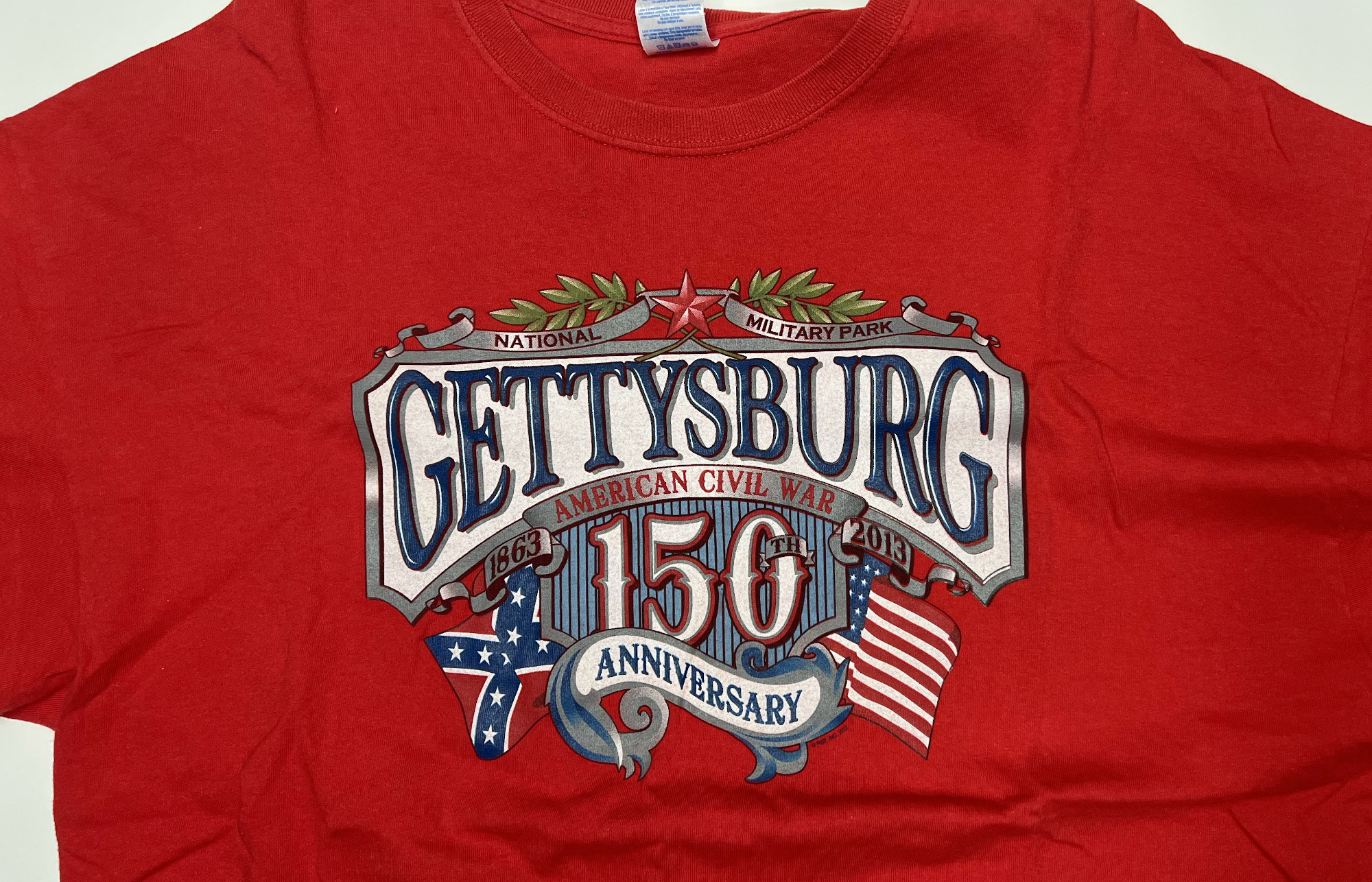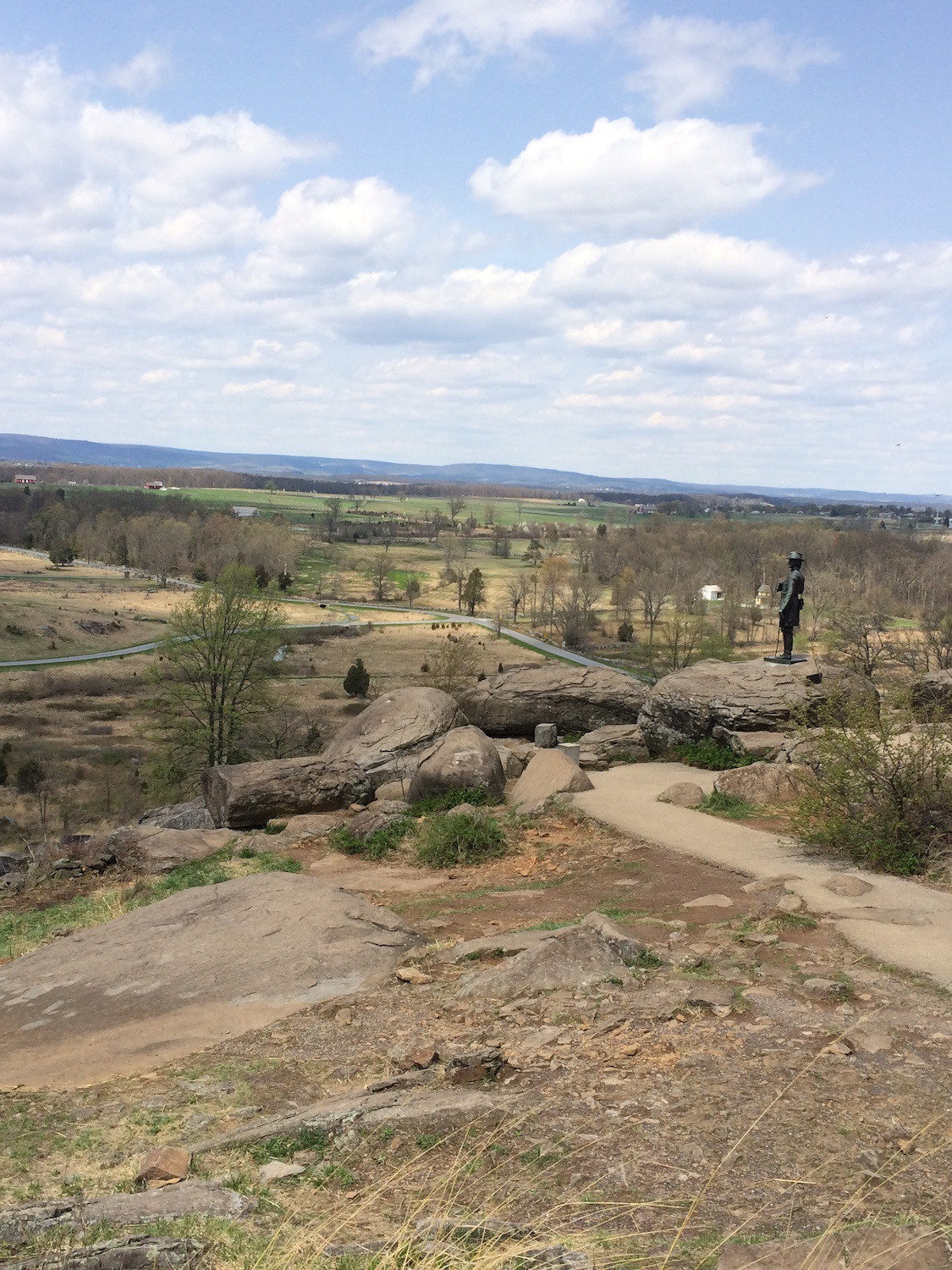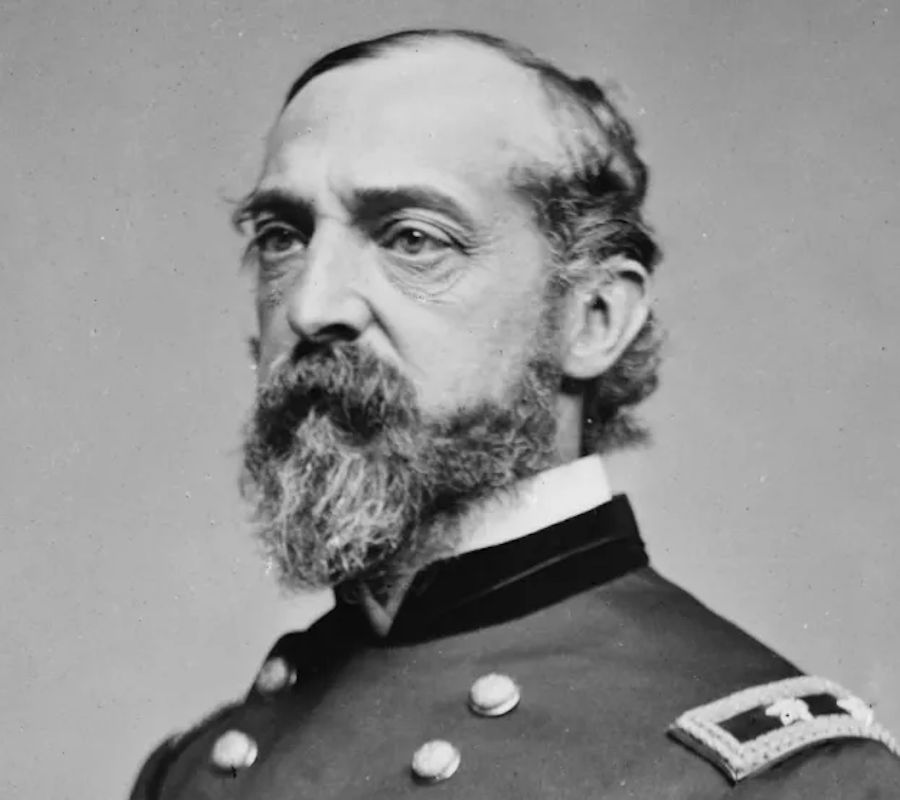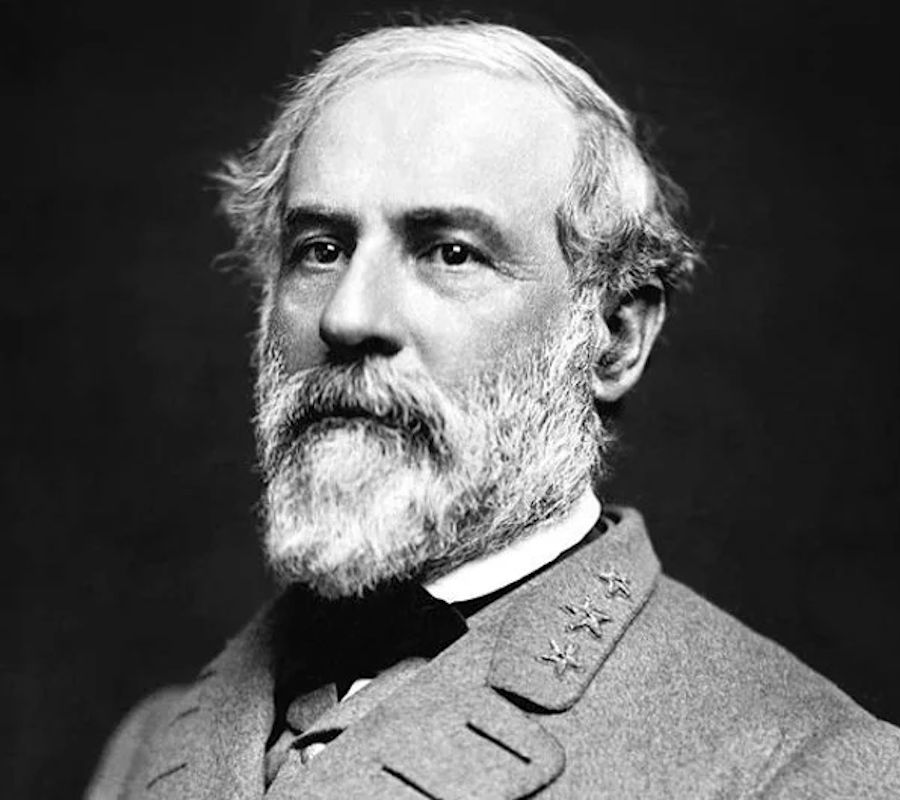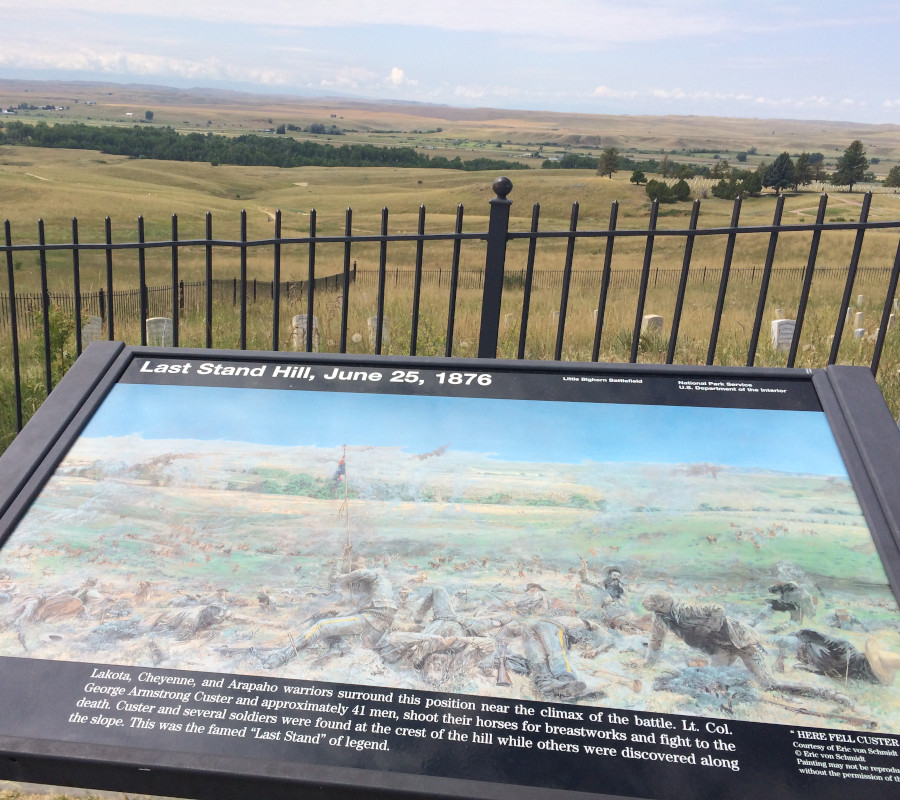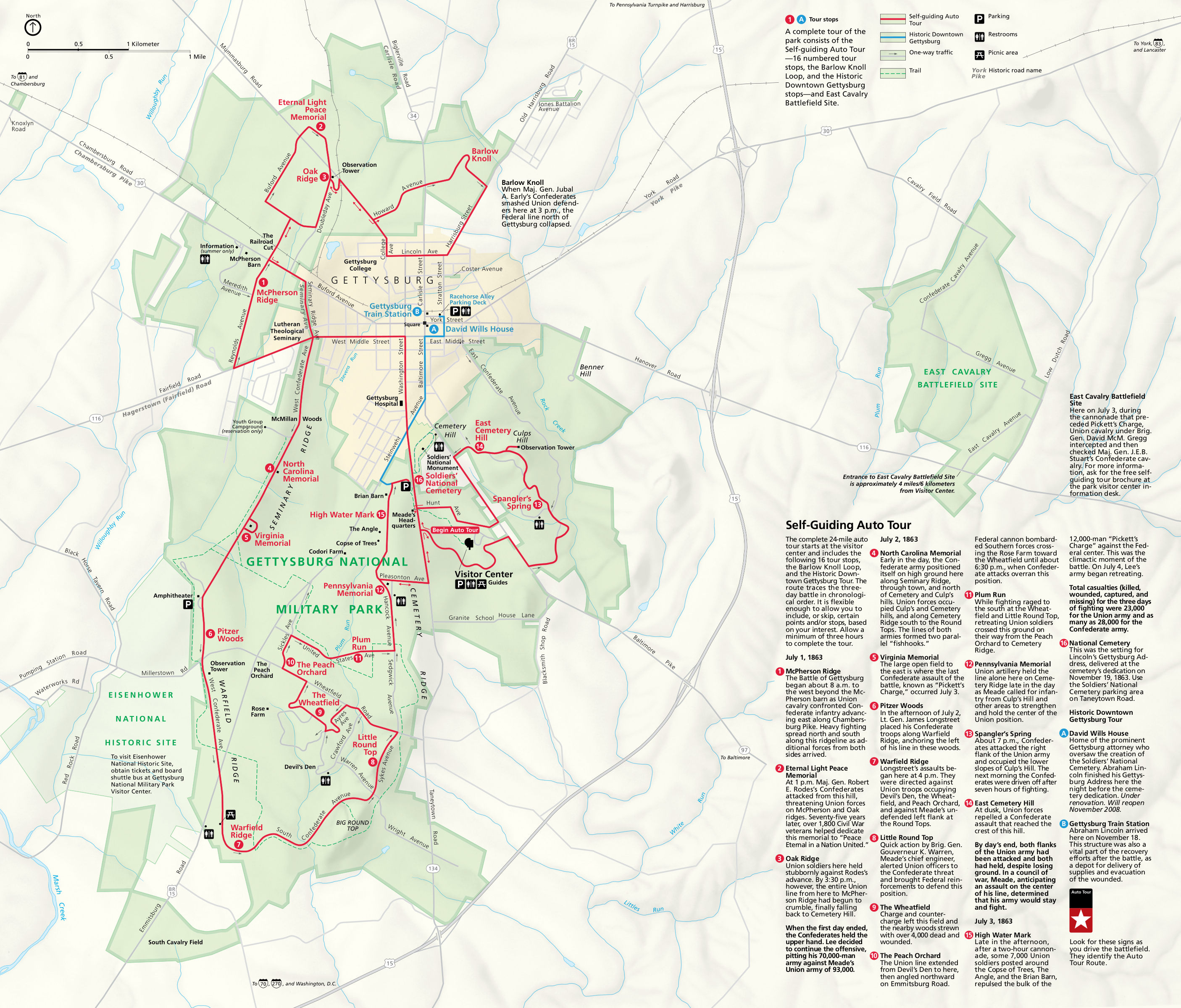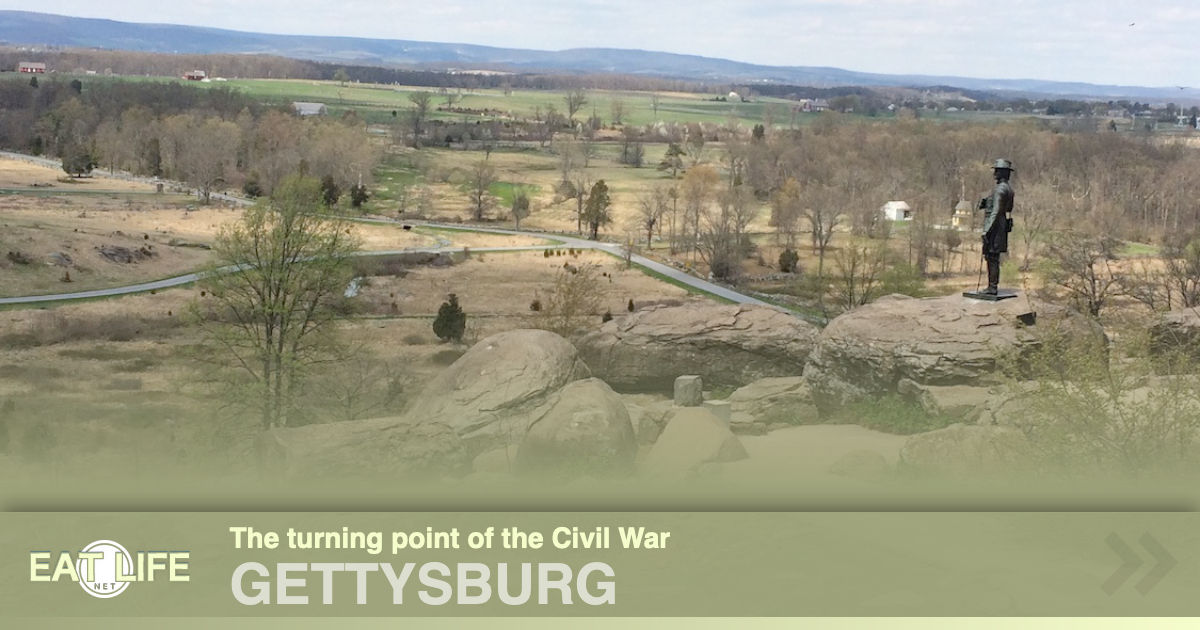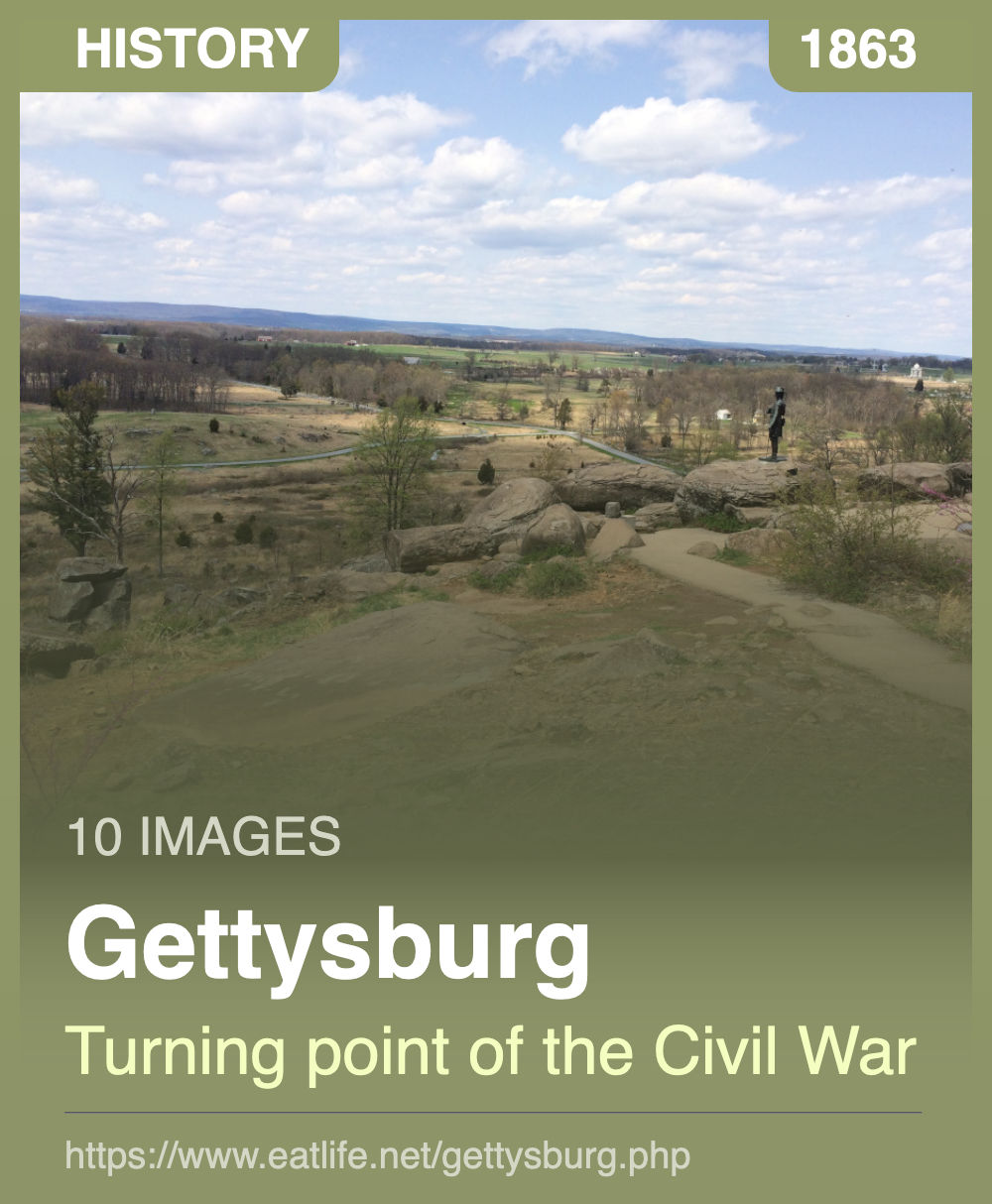The site of the bloodiest battle of the Civil War and one of the most visited places in the United StatesThe Battle of Gettysburg:
Marked the turning point of the Civil War. With more than 50,000 estimated casualties, the three-day engagement was the bloodiest single battle of the conflict.How it ended:
Union victory.Gettysburg ended Confederate general Robert E. Lee's ambitious second quest to invade the North and bring the Civil War to a swift end. The loss there dashed the hopes of the Confederate States of America to become an independent nation.
In context:
After a year of defensive victories in Virginia, Lee's objective was to win a battle north of the Mason-Dixon line in the hopes of forcing a negotiated end to the fighting. His loss at Gettysburg prevented him from realizing that goal. Instead, the defeated general fled south with a wagon train of wounded soldiers straining toward the Potomac. Union general Meade failed to pursue the retreating army, missing a critical opportunity to trap Lee and force a Confederate surrender. The bitterly divisive war raged on for another two years.https://www.battlefields.org/learn/civil-war/battles/gettysburg
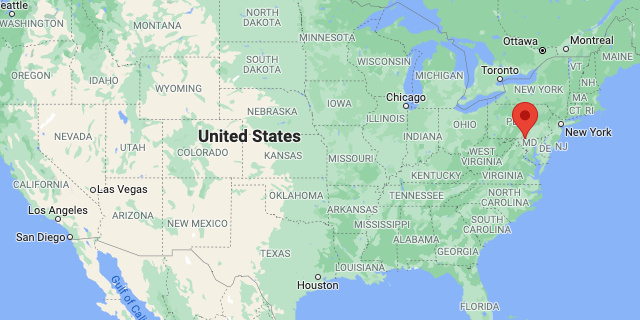
https://www.google.com/maps/place/Gettysburg
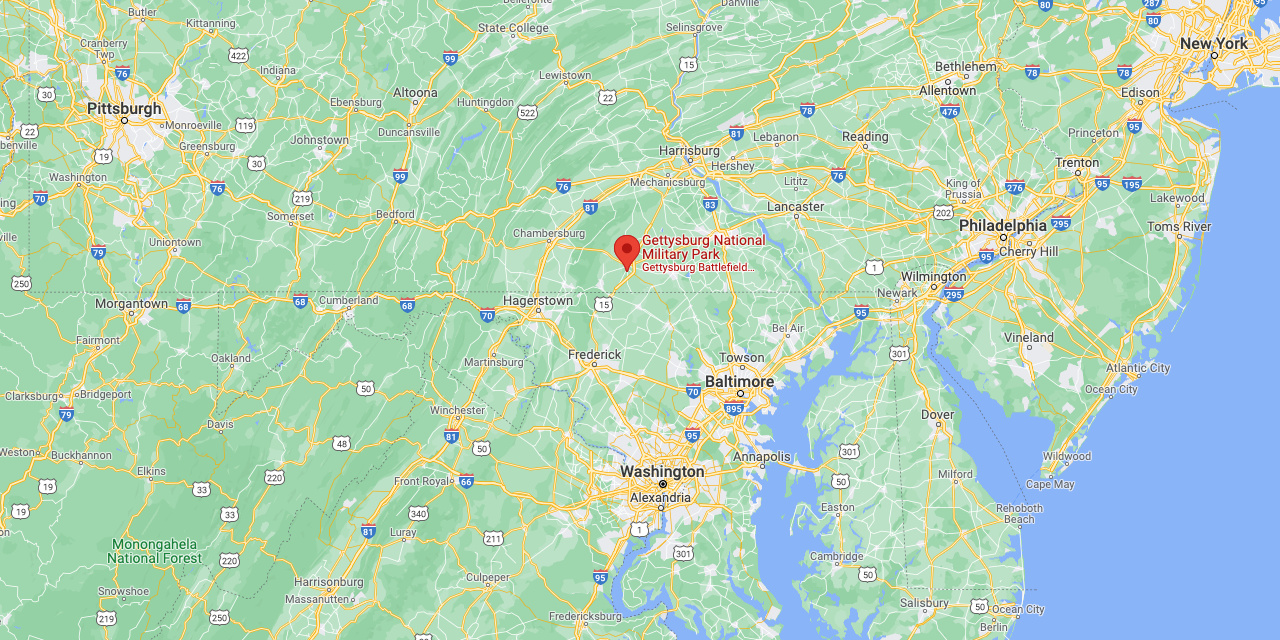
https://www.google.com/maps/place/Gettysburg+National+Military+Park
 Gettysburg Timeline:
Gettysburg Timeline:
Tuesday, June 30:
A Confederate infantry brigade from General A. P. Hill's corps heads toward Gettysburg, Pa., in search of supplies. The Confederates spot Union cavalry heading toward Gettysburg.
Wednesday, July 1:
Confederate commanders send troops to engage Brigadier General John Buford's cavalry at Gettysburg at McPherson Ridge. Union soldiers, under the command of Major General John F. Reynolds arrive midmorning to support Buford. Reynolds is soon killed by a bullet to the head. Confederate Army General Robert E. Lee arrives in Gettysburg mid-afternoon. By then, Union forces are on the retreat through the town of Gettysburg and regroup at Cemetery Hill. Lee orders Confederate General R.S. Ewell to attack at Cemetery Hill, but Ewell hesitates, giving Union troops time to bring in reinforcements and set up artillery. As night falls, the Union's lead commander at Gettysburg, Major General George Meade, orders all Union forces to Gettysburg -- in all, more than 90,000 troops.
Thursday, July 2:
Meade arrives in the middle of the night. Lee orders two of his generals, James Longstreet and Ewell, to attack the flanks of Union forces on Culp's Hill. But Longstreet delays, and attacks much later than Ewell, giving Union forces more time to strengthen their position.
The Union's Major General Daniel Sickles advances in front of the main line and comes under attack. The two sides engage in some of the fiercest fighting of the Civil War, ensuring that the locations Peach Orchard, Devil's Den, the Wheatfield and Little Round Top go down in history. Ewell attacks Union troops at Cemetery Hill and Culp's Hill, but Union forces hold their position. Late in the night, Lee decides on a gamble. On Friday, he will attack where least expected: at the center of the Union line along Cemetery Ridge.
Friday, July 3:
Fighting begins around 4 a.m. with cannon fire. Union artillery pounds the Rebels at the lower end of Culp's Hill. Union troops finally succeed in driving the Rebels from the hill, and fighting over Culp's Hill ends. Around 1 p.m., Confederate cannons open fire on the Union position at the center of Cemetery Ridge. The Union artillery slows its fire, to trick the Rebels into thinking they had knocked out the Union cannons.
General George Pickett commands 15,000 Confederate troops as they charge Cemetery Ridge. The Union artillery opens up again, devastating the Confederate line. The battered, outnumbered Rebels begin to retreat. Lee rides out to meet the survivors, taking all the blame. He reportedly says, "All this has been my fault. It is I who have lost this fight, and you must help me out the best way you can." The battle for Gettysburg is over. Gettysburg was the last attempt by the South to launch a major offensive in the northern states.
Nov. 19, 1863:
President Abraham Lincoln travels to Gettysburg, which he dedicates as a military cemetery. Lincoln tells the crowd, "in a larger sense, we cannot dedicate - we cannot consecrate - we cannot hallow this ground. The brave men, living and dead, who struggled here, have consecrated it, far above our poor power to add or detract."
https://www.npr.org/templates/story/story.php?storyId=1305860
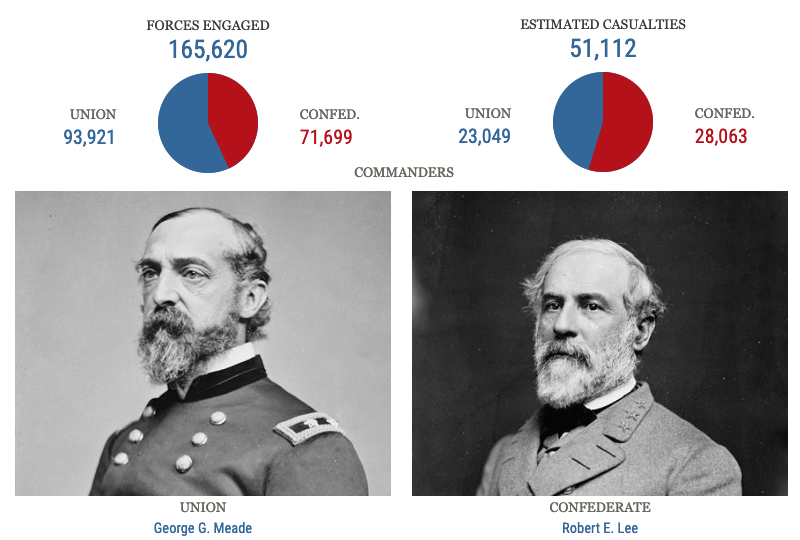
Early that morning a Confederate division under Major General Henry Heth marches toward Gettysburg to seize supplies. In an unplanned engagement, they confront Union calvary. Brigadier General John Buford slows the Confederate advance until the infantry of the Union I and XI Corps under Major General John F. Reynolds arrives. Reynolds is killed in action. Soon Confederate reinforcements under generals A.P. Hill and Richard Ewell reach the scene. By late afternoon, the wool-clad troops are battling ferociously in the sweltering heat. Thirty thousand Confederates overwhelm 20,000 Federals, who fall back through Gettysburg and fortify Cemetery Hill south of town.
July 2:
On the second day of battle, the Union defends a fishhook-shaped range of hills and ridges south of Gettysburg.
The Confederates wrap around the Union position in a longer line.
That afternoon Lee launches a heavy assault commanded by Lieut. General James Longstreet on the Union left flank.
Fierce fighting rages at Devil's Den, Little Round Top, the Wheatfield, the Peach Orchard, and Cemetery Ridge as Longstreet's men close in on the Union position.
Using their shorter interior lines, Union II Corps commander Major General Winfield S. Hancock and others move reinforcements quickly to blunt Confederate advances.
On the Federal right, Confederate demonstrations escalate into full-scale assaults on East Cemetery Hill and Culp's Hill.
Although the Confederates gain ground on both ends of their line, the Union defenders hold strong positions as darkness falls.
July 3:
Believing his enemy to be weakened, Lee seeks to capitalize on the previous day's gains with renewed attacks on the Union line.
Heavy fighting resumes on Culp's Hill as Union troops attempt to recapture ground lost the previous day.
Cavalry battles flare to the east and south, but the main event is a dramatic infantry assault by 12,500 Confederates commanded by Longstreet against the center of the Union position on Cemetery Ridge.
Though undermanned, the Virginia infantry division of Brigadier General George E. Pickett constitutes about half of the attacking force.
Pickett, ordered by Lee to advance his division toward the enemy through a mile of unprotected farmland, replies, "General, I have no division," but the order stands.
During Pickett's Charge, as it is famously known, only one Confederate brigade temporarily reaches the top of the ridge—afterwards referred to as the High Watermark of the Confederacy.
This daring strategy ultimately proves a disastrous sacrifice for the Confederates, with casualties approaching 60 percent.
Repulsed by close-range Union rifle and artillery fire, the Confederates retreat. Lee withdraws his army from Gettysburg late on the rainy afternoon of July 4 and trudges back to Virginia with severely reduced ranks of wasted and battle-scarred men.
https://www.battlefields.org/learn/civil-war/battles/gettysburg
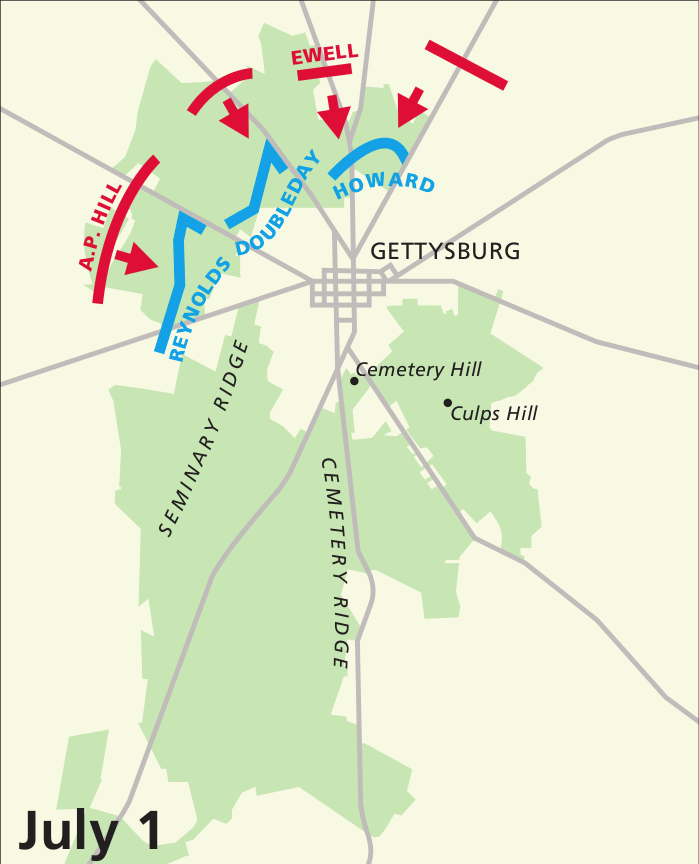
The Confederate attack and the Union's defense north of the town of Gettysburg
The First Day:
Union General John Buford arrived in Gettysburg with two cavalry brigades on June 30th 1863. They were the first Union troops to arrive in Gettysburg and while they were never directly ordered to defend the town, Buford decided that they would. He was a wise man and understood that the best tactic he could employ was to set his men in a defensive position to buy some time while waiting for the main army to arrive. So, he placed his men on McPherson's ridge for the night.The Morning:
The battle of Gettysburg begins. It was Confederate General Heth that ordered the first attack on the cavalry that was defending Gettysburg up on McPherson's ridge. Two Confederate brigades advanced, with the intention to quickly defeat the Union, however were in for a surprise as the Union troops fought brilliantly and held them off for two hours which is when Union General John Reynolds and his veteran infantry corps arrived. Reynolds is said to have been killed upon arrival however, his men fought hard driving the Confederates away from McPherson's ridge and inflicting a great deal of casualties in the process.2 PM
A second attack was launched. Confederate Lieutenant General Richard Ewell's corps charged the Union line in their right flank. Upon seeing this as a successful tactic, Confederate General Robert E. Lee ordered an attack along the entire line. The Union troops were quickly overwhelmed and fled. In response, Union General Howard ordered a general retreat to higher ground on Cemetery Ridge. Lee quickly realized that the Union retreat to Cemetery Ridge would put their opposition in an excellent defensive position and suggested that Ewell to take control of it. However, despite the urging of his subordinates, Ewell decided against it. Meanwhile, on the Union side, General Hancock had arrived, calmed down the troops and decided they were in an advantageous defensive position. It was this knowledge that led to the Union to decide to stay put. And, with this decision, day one of the battle of Gettysburg came to a close.https://www.gettysburgbattlefieldtours.com/the-battle-of-gettysburg-day-one
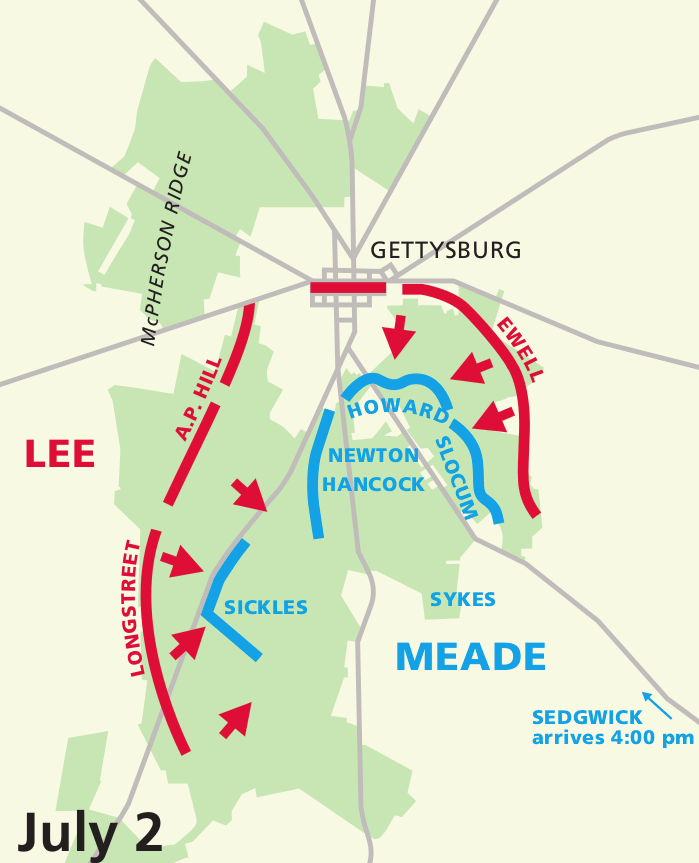
The Union's new defensive line south of town, after Day 1's Confederate successes
The Second Day:
The Union troops were advantageously positioned on both Cemetery Ridge and McPherson's Hill with the Confederate camp keenly aware of their opposition's wise tactic.Overnight both sides had received reinforcements which bolstered confidences all around. The first move of the day went to Confederate General Robert E. Lee who ordered General James Longstreet to attack the Union's left flank. The assumption was that the maneuver would come as a surprise since the Union would be preoccupied with the Confederates which were in plain sight on Culp's Hill. Longstreet wasn't convinced as to the effectiveness of this strategy and took his time getting to the attack position only to arrive and find that an entire Union corp was in the way! They had no choice but to fight.
Around the same time, Lee ordered General Ewell to "make a demonstration" against the main Union line which would prevent their opposition from shifting troops to the south to reinforce their lines.
The attack on the main Union line began with an artillery bombardment which was executed under the leadership of Confederate General Hood. This progressed into very bloody fighting including oftentimes hand-to-hand combat as the Confederates fought their way through Devil's Den and onwards to Little Round Top. It was here that they ran into the 20th Maine under the leadership of Union General Joshua Chamberlain. The Confederates charged the 20th Maine three times only to be beaten back each. This led to their retreat to Little Round Top during which time Chamberlain ordered his men to fix bayonets and sweep the rebels from the Hill.
Meanwhile, the other attack had turned extremely bloody also as the Confederates pushed their way through an easily overwhelmed Union line. However, the rebels were eventually forced to withdraw after the Union received reinforcements. Around the same time, Confederate General Richard Anderson began his attack on the Union lines within the center of Gettysburg.
Unfortunately, this section of the Union had thinned out his lines to reinforce other areas receiving the brunt of the Confederate attacks. The rebels had initial success of taking over however, it was short lived as the 1st Minnesota regiment arrived and effectively held back the rebels while giving the Union Generals time to successfully strategize.
The last attack of the day was executed at 7pm. It was the "demonstration" that Lee had ordered Ewell to make. As with much of the Confederate's attacks that day, it began with some success however, Union reinforcements left the rebels at a disadvantage and eventually led to their retreat. While Lee came close to breaking Union lines, he ultimately failed to do so on this second bloody day of battle. Casualties were very high with both sides losing approximately 10,000 men each. Shaken by this realization, Union Generals called a meeting to vote on remaining at Gettysburg or withdrawing. It was unanimous – stay and fight.
https://www.gettysburgbattlefieldtours.com/the-battle-of-gettysburg-day-two
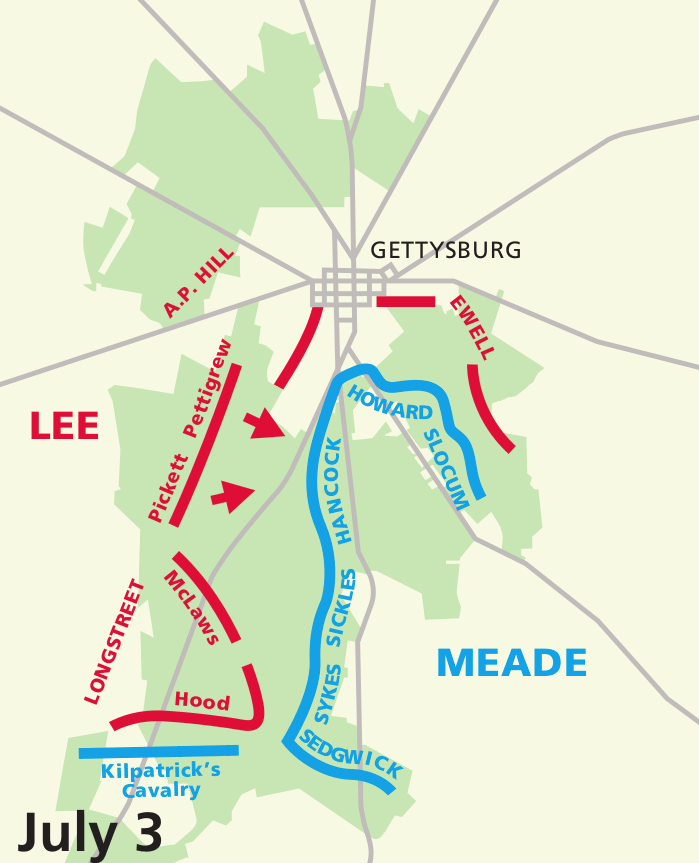
The lines during the final bloodiest day of the battle culminating in a Union victory.
The Third Day:
The third day of the battle of Gettysburg opened with both sides having received reinforcements which restored their numbers to the same as the beginning on the war. The Union was the first to strike by attacking the Confederate troops on Culp's Hill in hopes of regaining territory lost the day prior. The battle lasted 8 hours and ended with the Confederate troops retreating. Meanwhile, Lee was busy planning the main attack on Gettysburg which we know today as Pickett's Charge. The tactic was to attack the center of the Union's troops while sending more troops to attack from the rear which would result in the splitting of the Union troops. Lee believed that if this tactic was successful, the win would be theirs.1 PM
The Confederate artillery opened fire on the Union center which lead to one hour of the most massive artillery bombardment of the Civil War.2 PM
The Union slowed their firing in an attempt to trick the Confederates into believing they had knocked out the Union guns.3 PM
The trick worked, the Confederates stopped firing. It was at this time that the commander of the Confederate artillery convinced Pickett they needed to charge now which lead Pickett to seek and receive permission from Longstreet to carry out the charge. Over 12,000 troops lined up and started the march across a field towards a small clump of trees behind Federal lines. Halfway across the field, the Union fired upon the Confederates from their advantageous positions on Cemetery Hill and Little Round Top. The Confederates bravely pushed forward through not only the artillery but a small fence which caused disruptions to the formation making them an easier target (if you can imagine). They continued forward until they reached a small stone wall which was their destination. The remaining men rushed the stone wall and brutal hand-to-hand combat ensued.The Union quickly reinforced their lines with fresh men and counterattacked. The rebels, expecting reinforcements that never showed, were forced to treat and fled back to their original lines. The troops were met by Lee as they returned to the Confederate lines. He encouraged them to be prepared for a counterattack by the Union that he felt was sure to come yet never did. An entire day passed with neither side making a move. The battle of Gettysburg came to an official close as the Union left Gettysburg for good under the cover of night on July 4th.
https://www.gettysburgbattlefieldtours.com/the-battle-of-gettysburg-day-three
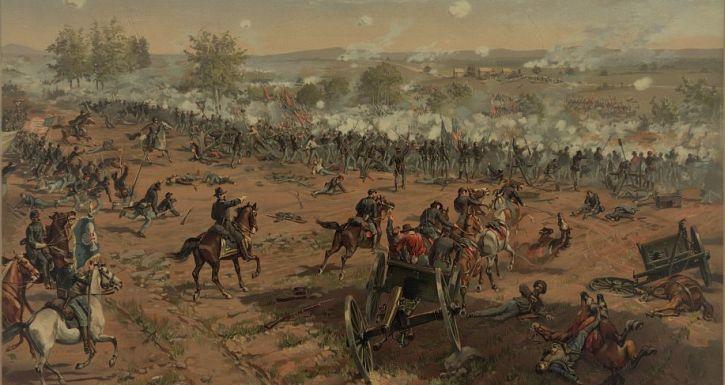
- The battle was fought at Gettysburg because of the area road system. The Town of Gettysburg, population 2,000, was a town on the rise. It boasted three newspapers, two institutes of higher learning, several churches and banks, but no shoe factory or warehouse. The ten roads that led into town are what brought the armies to Gettysburg.
- The First Day's battle was a much larger engagement than is generally portrayed. It involved some 50,000 soldiers of which roughly 15,500 were killed, wounded, captured or missing. The first day in itself ranks as the 12th bloodiest battle of the Civil War.
- The Second Day's Battle was the largest and costliest of the three days. Devil's Den, Little Round Top, the Wheatfield, the Peach Orchard, Cemetery Ridge, Trostle's Farm, Culp's Hill and Cemetery Hill. It involved at least 100,000 soldiers of which roughly 20,000 were killed, wounded, captured or missing. The second day in itself ranks as the 10th bloodiest battle of the Civil War.
- Of 120 generals present at Gettysburg, nine were killed. No other battle claimed as many general officers.
- Culp's Hill and Cemetery Hill were far more important than Little Round Top. They formed the center and right of the Union's main position and also protected the Union army's only real lifeline on July 2 and 3 - the Baltimore Pike. Had Confederates captured and controlled either of these two hills, the Union army would have had to leave the Gettysburg area. Even with its sweeping views and commanding height, the same cannot be said for Little Round Top.
- Pickett's Charge was large and grand but by no means the largest charge of the Civil War. Not even close. Pickett's Charge involved some 12,000 Confederate soldiers.
The Confederate charge at Franklin had roughly 20,000 Confederate troops.
The grand Confederate charge at Gaines' Mill had roughly 50,000 Confederate troops - The Battle of Gettysburg is by far the costliest battle of the Civil War but not necessarily the largest. The 160,000 troops present at Gettysburg are eclipsed by the more than 185,000 at Fredericksburg.
- 64 Medals of Honor awarded to Union soldiers for their actions at Gettysburg. The deeds spanned the battlefield and were awarded from wartime into the 21st century.
- The Gettysburg Address essentially said the same thing as the famous orator Edward Everett's 5,500 word speech but in 1/60th the time. Everett wrote to Lincoln: "I should be glad, if I could flatter myself that I came as near to the central idea of the occasion, in two hours, as you did in two minutes."
- While the Gettysburg Battlefield is well-preserved, there are still numerous parcels to be saved. We must continue to work to preserved this hallowed ground.
https://www.battlefields.org/learn/articles/10-facts-gettysburg
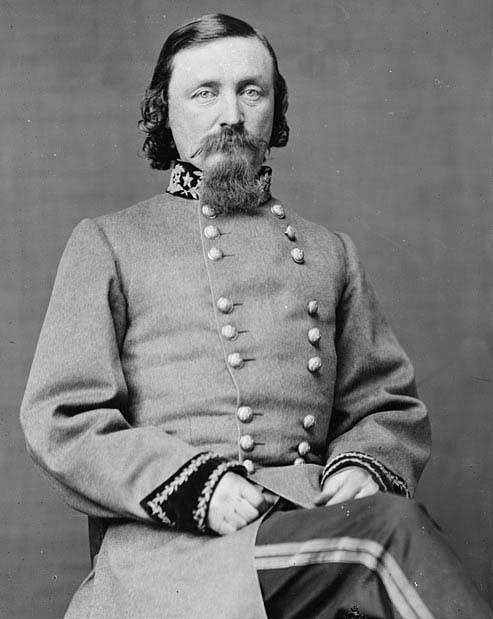
Pickett's Charge:
- The Confederates seemed to have won the first day and set up their line of attack.
- However, on the second day, Lee's attack on the two flanks was not successful and the Union Army was entrenched on the higher ground.
- Lacking other options, on the third day Lee sent General Ewell in the early morning to attack Culp's Hill for the second time, but the seven hour attempt failed.
- Lee then sent General J.E.B. Stuart's cavalry to attack from the rear; however, he was stopped by cavalry commanded by General George Armstrong Custer
Custer
After the war, would gain notoriety fighting Native Americans in the West and lose his life at the Battle of Little Big Horn.
- Finally, Lee decided on a frontal attack.
- The Confederates on Seminary Ridge faced the Union troops on Cemetery Ridge and between them was an open field with rolling swells. Lee had about 120 cannons aimed at the Union positions, which he wanted to knock out, or "soften the positions," enough so to allow his Rebels to cross an open field for about a mile before assaulting Cemetery Hill. Lee's cannons blasted away and overshot the Union lines, but causing some damage.
- General Meade had ordered his artillery of 90 on Cemetery Ridge to slacken their firing to make the Confederates think the guns had been destroyed. The strategy was successful, and during the slack time, the Union positions resupplied.
- Following the cannon barrage, Lee ordered his second in command, Lieutenant General James Longstreet, to convey his order to Generals Isaac Trimble, J. Johnston Pettigrew and George Pickett to attack the center of the Union's line of defense on Cemetery Ridge.
The Confederate attack though is attributed historically to Major General George Edward Pickett who led the assault
- 12000 Confederates moved forward, crossing Emmitsburg Road, then into the field, weaving with the rolling hills so they would not be easy targets. They encountered heavy fire from the beginning.
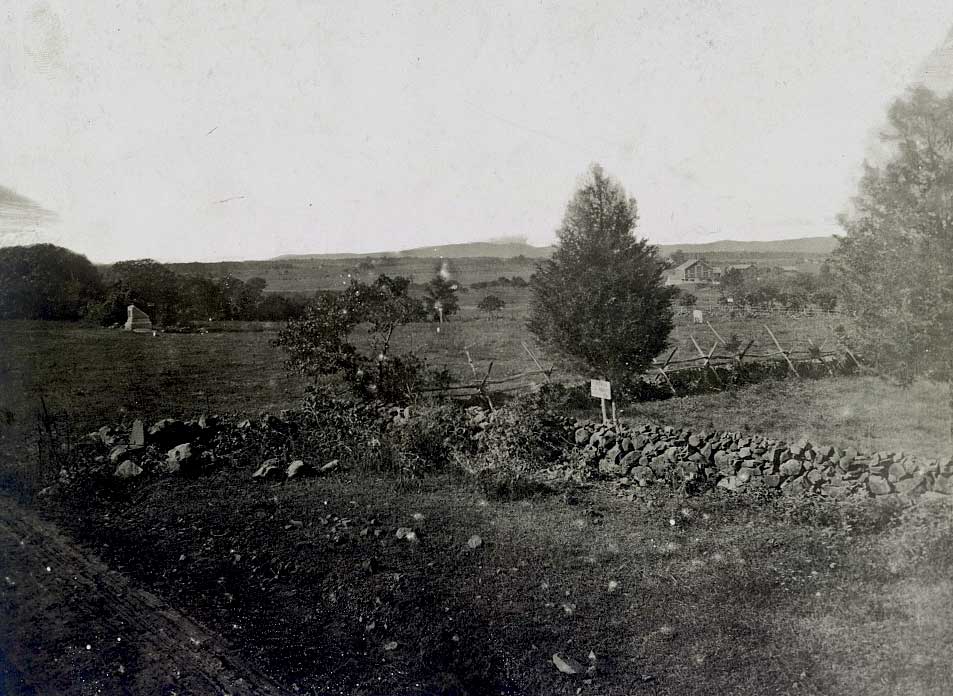
- The Union troops waited until they were well into the field and then began to open fire, accurately hitting their targets.
- Undeterred, the Confederates pushed ahead into the shelling of Union cannons and rifle fire. In places fighting became hand-to-hand combat.
- About a hundred of General Pickett's men briefly broke through the Union lines, encountering first the raw troops of the Second Corps and reaching the high point of the attack, a low stone wall that marked the crest of Cemetery Ridge, which came to be called as High Water Mark.
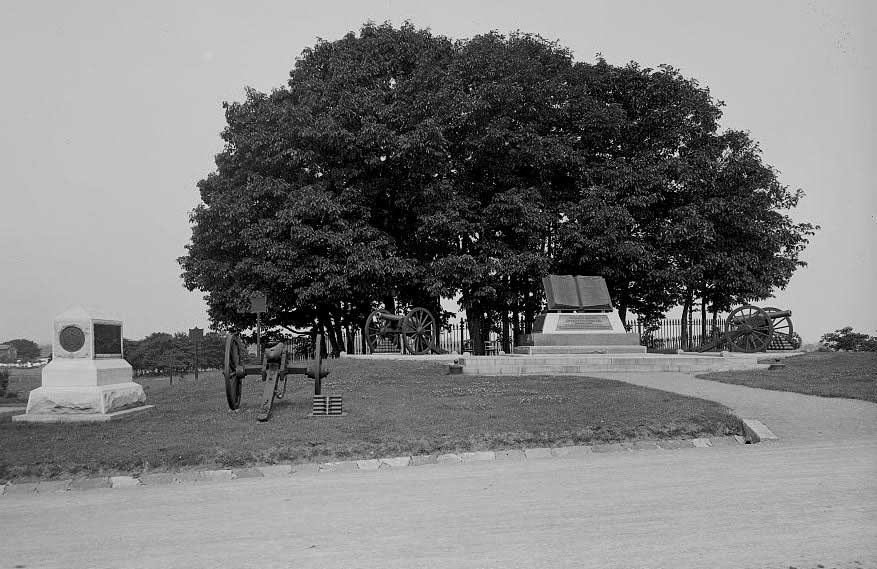
- In a stonewall near a clump of trees, General Pickett planted a Confederate flag.
- Facing decimating firepower from the First Corps, however, Pickett's men suffered heavy losses and were forced to retreat.
- With enormous numbers of dead and wounded, General Lee pulled his troops back and stopped the assault. The next day, they withdrew to Virginia. Lee had lost nearly a third of his troops.
July 1, 1863
- McPherson Ridge:
The Battle of Gettysburg began about 8 a.m. to the west beyond the McPherson barn as Union cavalry confronted Confederate infantry advancing east along Chambersburg Pike. Heavy fighting spread north and south along this ridgeline as additional forces from both sides arrived. - Eternal Light Peace Memorial:
At 1 p.m. Major General Robert E. Rodes's Confederates attacked from this hill, threatening Union forces on McPherson and Oak ridges. Seventy-five years later, over 1,800 Civil War veterans helped dedicate this memorial to "Peace Eternal in a Nation United. - Oak Ridge:
Union soldiers here held stubbornly against Rodes's advance. By 3:30 p.m., however, the entire Union line from here to McPherson Ridge had begun to crumble, finally falling back to Cemetery Hill. When the first day ended, the Confederates held the upper hand. Lee decided to continue the offensive, pitting his 70,000-man army against Meade's Union army of 93,000. - North Carolina Memorial:
Early in the day, the Confederate army positioned itself on high ground here along Seminary Ridge, through town, and north of Cemetery and Culp's hills. Union forces occupied Culp's and Cemetery hills, and along Cemetery Ridge south to the Round Tops. The lines of both armies formed two parallel "fishhooks. - Virginia Memorial:
The large open field to the east is where the last Confederate assault of the battle, known as "Pickett' Charge," occurred July 3. - Pitzer Woods:
In the afternoon of July 2, Lieutenant General James Longstreet placed his Confederate troops along Warfield Ridge, anchoring the left of his line in these woods. - Warfield Ridge:
Longstreet's assaults began here at 4 p.m. They were directed against Union troops occupying Devil's Den, the Wheatfield, and Peach Orchard, and against Meade's undefended left flank at the Round Tops. - Little Round Top:
Quick action by Brigadier General Gouverneur K. Warren, Meade's chief engineer, alerted Union officers to the Confederate threat and brought Federal reinforcements to defend this position. - The Wheatfield:
Charge and counter-charge left this field and the nearby woods strewn with over 4,000 dead and wounded. - The Peach Orchard:
The Union line extended from Devil's Den to here, then angled northward on Emmitsburg Road.Federal cannon bombarded Southern forces crossing the Rose Farm toward the Wheatfield until about 6:30 p.m., when Confederate attacks overran this position.
- Plum Run:
While fighting raged to the south at the Wheatfield and Little Round Top, retreating Union soldiers crossed this ground on their way from the Peach Orchard to Cemetery Ridge. - Pennsylvania Memorial:
Union artillery held the line alone here on Cemetery Ridge late in the day as Meade called for an infantry from Culp's Hill and other areas to strengthen and hold the center of the Union Position. - Spangler's Spring:
About 7 p.m., Confederates attacked the right flank of the Union army and occupied the lower slopes of Culp's Hill. The next morning the Confederates were driven off after seven hours of fighting. - East Cemetery Hill:
At dusk, Union forces repelled a Confederate assault that reached the crest of this hill. - High Water Mark:
Late in the afternoon, after a two-hour cannonade, some 7,000 Union soldiers posted around the Copse of Trees, The Angle, and the Brian Barn, repulsed the bulk of the 12.000-man "Pickett's Charge" against the Federal center. This was the climactic moment of the battle. On July 4, Lee's army began retreating. - National Cemetery:
This was the setting for cemetery's dedication on November 19, 1863. Use the Soldiers' National Cemetery parking area on Taneytown Road.
July 2, 1863
By day's end, both flanks of the Union army had been attacked and both had held, despite losing ground. In a council of war, Meade, anticipating an assault on the center of his line, determined that his army would stay and fight.
July 3, 1863
Total casualties (killed, wounded, captured, and missing) for the three days of fighting were 23,000 for the Union army and as many as 28,000 for the Confederate army.
Historic Downtown Gettysburg Tour
- A - David Wills House:
Home of the prominent Gettysburg attorney who oversaw the creation of the Soldiers' National Cemetery. Abraham Lincoln finished his Gettysburg Address here the night before the cemetery dedication. Under renovation. Will reopen November 2008. - B - Gettysburg Train Station:
Abraham Lincoln arrived here on November 18. This structure was also a vital part of the recovery efforts after the battle, as a depot for delivery of supplies and evacuation of the wounded.
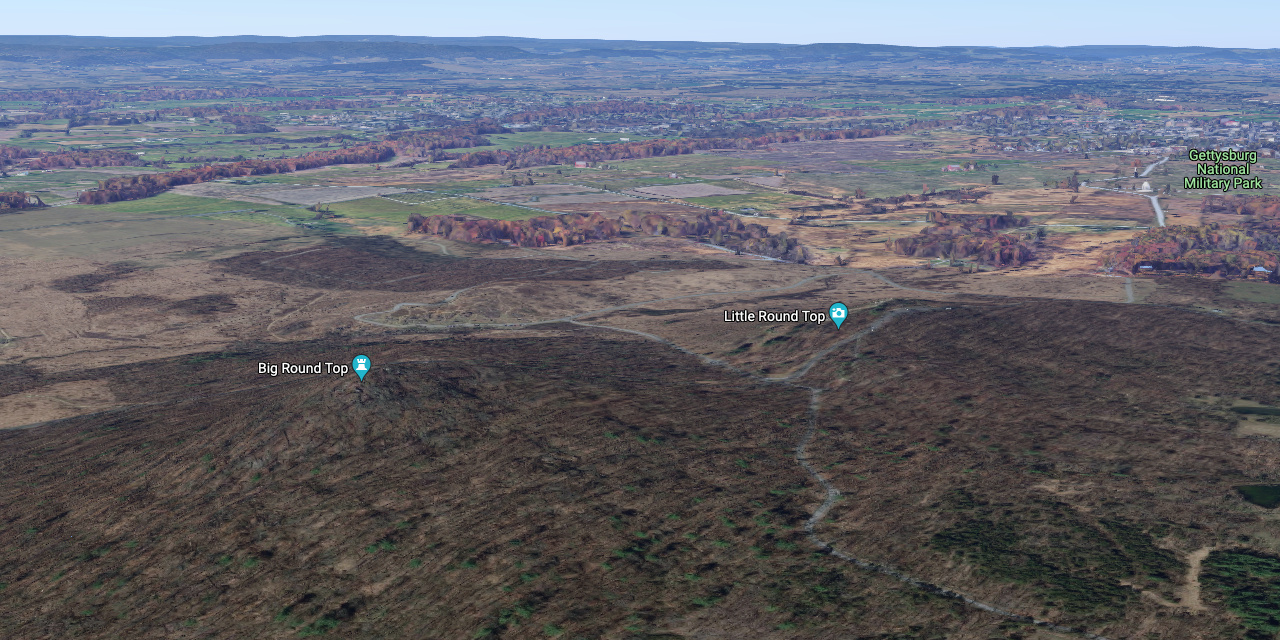
https://www.google.com/maps/place/Little+Round+Top
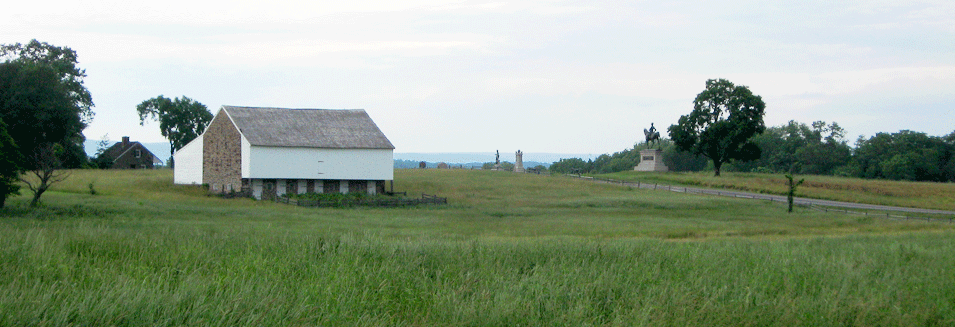
McPherson's Ridge is a branch of Oak Ridge which lies across Chambersburg Pike (U.S. 30). Some of the fiercest fighting of the battle took place here on July 1. The ridge takes its name from the farm of Edward McPherson, whose barn still stands. The ridge rises some fifty feet above Willoughby Run to its west and is about the same height as Seminary Ridge to its east, separated by two shallow swales. To its north (to the right in the photo) it slopes gradually upward to Oak Hill, about a mile away and 70 feet higher in elevation. One of the Railroad Cuts extends laterally through the ridge, paralleling the Chambersburg Pike.
The photo shows McPherson Ridge from the east. On the left is the McPherson barn, with U.S. 30 running from the right side of the picture past the monuments to General Reynolds, the 149th Pennsylvania, and the 2nd Maine Battery.
https://gettysburg.stonesentinels.com/battlefield-terrain/mcpherson-ridge
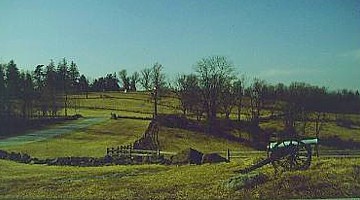
East Cemetery Hill, usually called Cemetery Hill, is one of the premier landmarks of the battlefield, situated on the southern edge of Gettysburg overlooking the town and immediate area south of it. Originally known as "Raffensberger's Hill", its better known name began in 1858 when Evergreen Cemetery was established on the summit. Both Union and Confederate commanders referred to this height as Cemetery Hill during the battle. The first troops on the hill were those of General O.O. Howard's Eleventh Corps, who arrived on the battlefield around noon of July 1st. Later that afternoon, General Winfield Scott Hancock, sent to the battlefield by General Meade, rallied Union troops here and re-organized the intermingled regiments after the fighting west and north of town. Hancock and Howard both realized the strength of this position.
The hill was divided into small pastures, bordered on all sides with stone walls. General Howard placed his Eleventh Corps troops behind these man-made defenses while artillerymen constructed earthen barricades or "lunettes", for protection around their cannons, which were placed behind the infantrymen. By the morning of July 2nd, East Cemetery Hill was one of the most heavily fortified positions on the field, its base ringed with infantry and three artillery batteries crowning the summit. The western slope of Cemetery Hill, where the Soldiers National Cemetery is today, was also heavily fortified with infantry and artillery.
http://www.thomaslegion.net/battleofgettysburgeastcemeteryhill.html
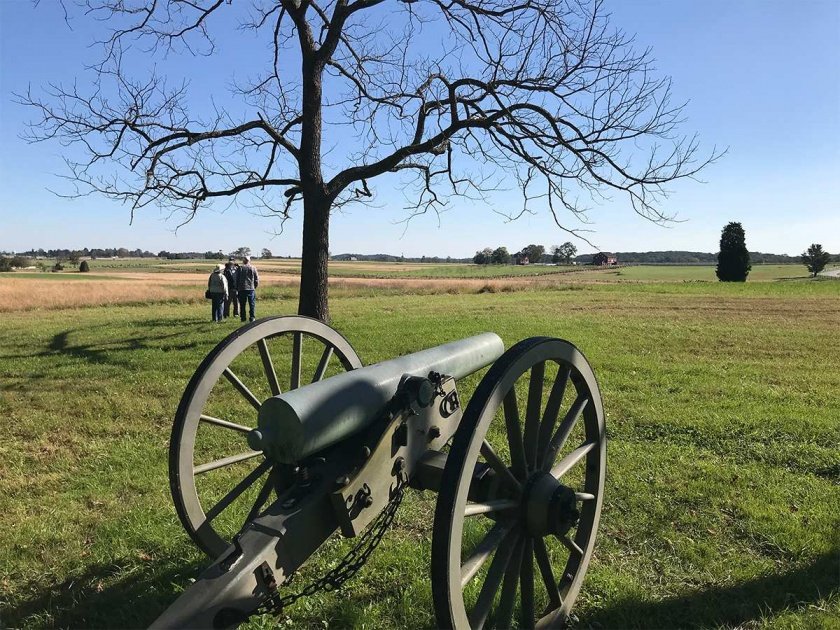
In July, 1863, the Army of Northern Virginia posted artillery and infantry along Seminary Ridge. Likewise, one mile away and parallel to this battle line, the Army of the Potomac took a defensive position on Cemetery Ridge. Then in the late afternoon of July 3, the Confederate army charged to the opposing side. This failed action was Picketts Charge.
Prior to the charge to the ridge Longstreet ordered an artillery bombardment. Colonel James B. Walton led Longstreet's 1st Corps Artillery Reserve, which consisted of two battalions from Virginia, South Carolina, and Louisiana.
https://civilwarcycling.com/index/gettysburg-landscape-seminary-ridge
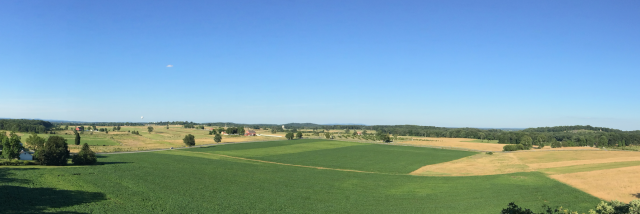
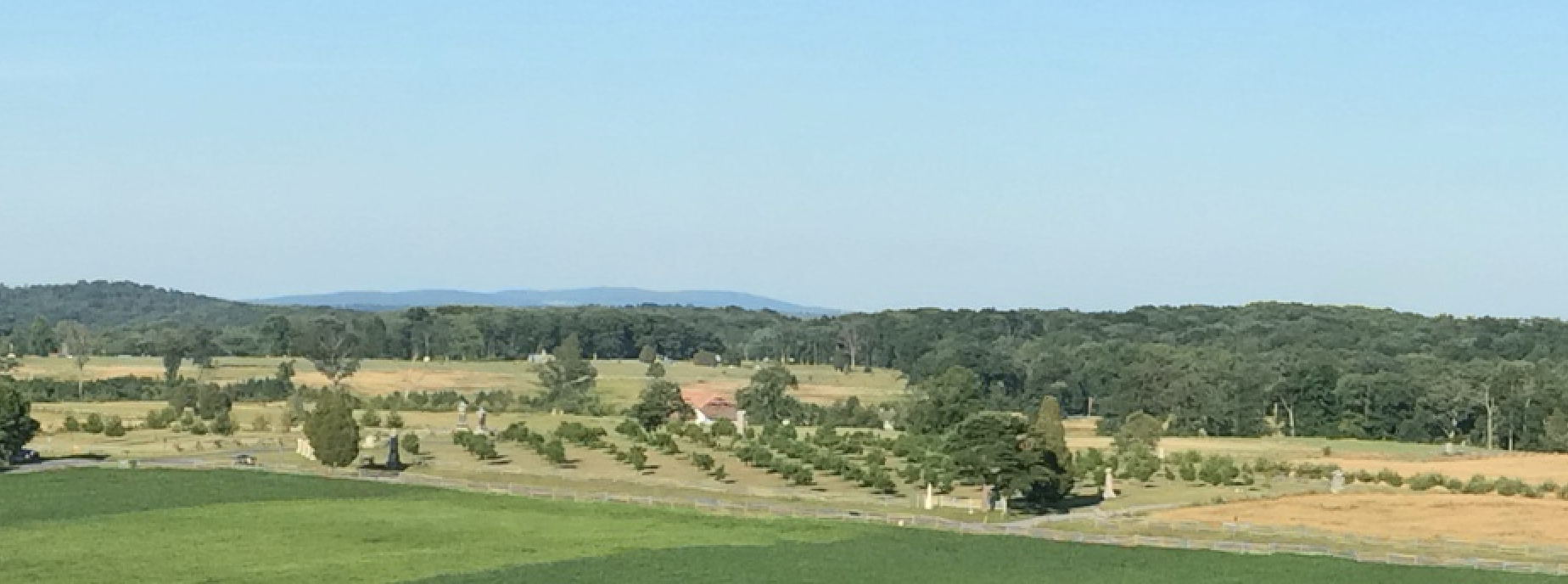 Zoomed in a little
Zoomed in a little
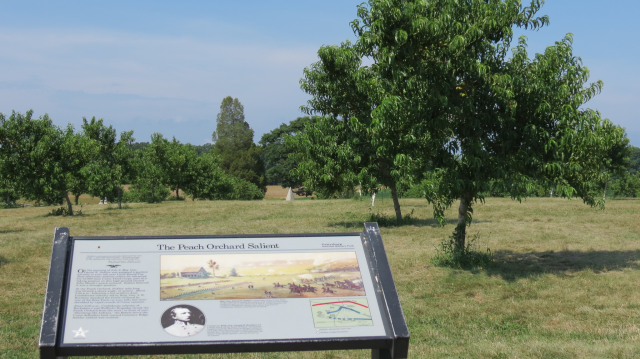 The Sherfy Peach Orchard:
The Sherfy Peach Orchard:
Deacon Sherfy owned two small-sized parcels of land, the larger of which straddled the Emmitsburg Road and wrapped around the intersection of the lane leading down to Rose's wheat field. At this corner, Sherfy had built a highly successful operation in "canned and dried fruits," which made the peach orchard he planted on the southeast corner of the intersection a landmark of sorts on Adams County's 1858 survey map. The stumpy, thick-branched peach trees were arranged in rows on a seven-and-a-half-acre rectangle, and sat on a slight knob that gave an unobstructed view of the ground to the north (to Cemetery Hill) and to the southeast (to the stony ridge and the Rose farm). The knob was originally supposed to serve as the pivot point for the great wheel Longstreet's corps would make up the Emmitsburg Road, and provide an extra bonus in the form of a platform for his artillery to cover them, since (as Lee afterward wrote) "our artillery could be used to advantage in assailing the more elevated ground beyond." - Guelzo, Allen C. (2013-05-14). Gettysburg: The Last Invasion (Kindle Locations 6543 6550). Knopf Doubleday Publishing Group. Kindle Edition.
The Mississippi brigade drove forward at the double-quick and "literally rushed the goal," yipping the rebel yell "with the savage courage of baited bulls." They struck the peach orchard squarely on its angle, the 21st Mississippi wrapping around to crush the south side of the orchard, and the remaining three regiments rolling straight for Graham's brigade. Three of Graham's regiments moved to the east side of the road to support one of the 3rd Corps artillery batteries beside the Sherfy barn, but they did not stay there long. As the Mississippians advanced "to within 40 yds," the 68th Pennsylvania, which "formed an angle fronting on the pike," was first to fold. Hit from two sides, the 68th crumbled "retiring slowly and contesting the ground inch by inch." Next to go was the 114th Pennsylvania, whose gaudy Zouave uniforms promptly began littering the yard around the Sherfy barn, windmill, and canning house. "Every door, window and sash of the Sherfy house was shivered to atoms" and the barn was "riddled like a sieve from base to roof." George Gerald, the major of the 18th Mississippi, led a surge up to the barn, kicked in the barn door, "and within less than two minutes we had killed, wounded or captured every man in the barn."
In Joseph Sherfy's peach orchard, "only skeletons of trees" were "left; there was scarcely a leaf remaining," and Sherfy's house had been ransacked, "turning everything in drawers etc. out and clothes, bonnets, towels, linen etc. were found tramped in indistinguishable piles and filth of every description was strewn over the house." At least Sherfy still had the house; the Sherfy barn had caught fire and burned to the ground, and William Bliss' house and barn had been deliberately torched. - Guelzo, Allen C. (2013-05-14). Gettysburg: The Last Invasion (Kindle Locations 6620 6630). Knopf Doubleday Publishing Group. Kindle Edition.
https://gettysburgmatters.wordpress.com/encyclopedia/the-sherfy-peach-orchard
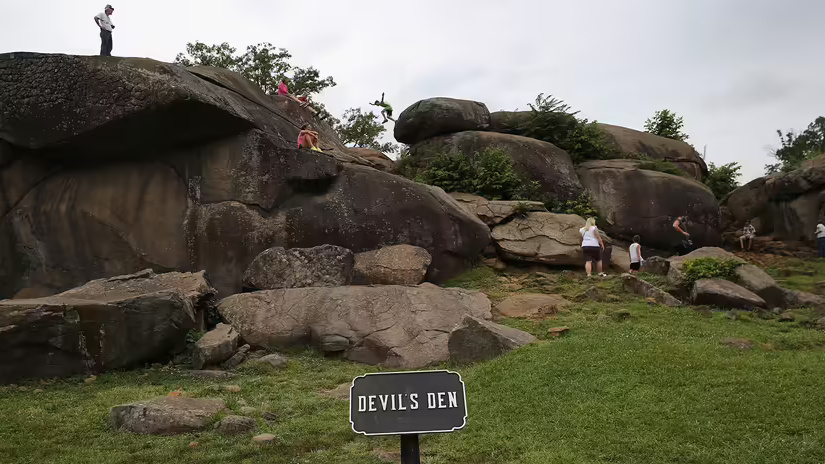
Known as Devil's Den, this boulder-strewn maze located between the rocky hills known as Little Roundtop and Big Roundtop was a site of fierce fighting and heavy casualties.
The name Devil's Den predates the Civil War, though the origin is uncertain. Still, it's not hard to imagine why the spooky moniker stuck. The Devil's Den looks like some giant just dropped these huge boulders the size of houses down onto this one spot on the battlefield.
The fighting at Devil's Den was intense and dictated by the unusual topography. On the second day of the Battle of Gettysburg, 5,500 Confederate troops attacked the left flank of the Union position on Little Roundtop. To get there, they first had to take Devil's Den, where the maze of boulders made it nearly impossible to see the enemy.
"It would have been scary," says Nesbitt. "You turn a corner and there's somebody with a bayonet."
The turning point of the battle for Devil's Den came with a siege from the Confederate 1st Texas regiment under the command of Major General John Bell Hood. The famously ragtag group of soldiers faced heavy casualties — Hood himself was shot in the arm — but managed to silence three of the Union's four heavy artillery guns and flush the remaining Union soldiers from Devil's Den. Once in position, the 1st Texas installed sharpshooters between the 20-foot (6-meter) boulders to pick off Union officers on Little Roundtop.
Casualties from the fighting at Devil's Den totaled more than 1,800 for the Confederates and more than 800 for the Union. One swampy section of open land between the boulders and Little Roundtop earned the name the "Slaughter Pen" for how many soldiers from both sides were gunned down in crossfire.
The battle for Devil's Den is considered a Confederate victory, although the South would ultimately lose the larger Battle of Gettysburg the next day after the failure of the infamous full-frontal assault known as Pickett's Charge.
https://history.howstuffworks.com/american-civil-war/devils-den.htm
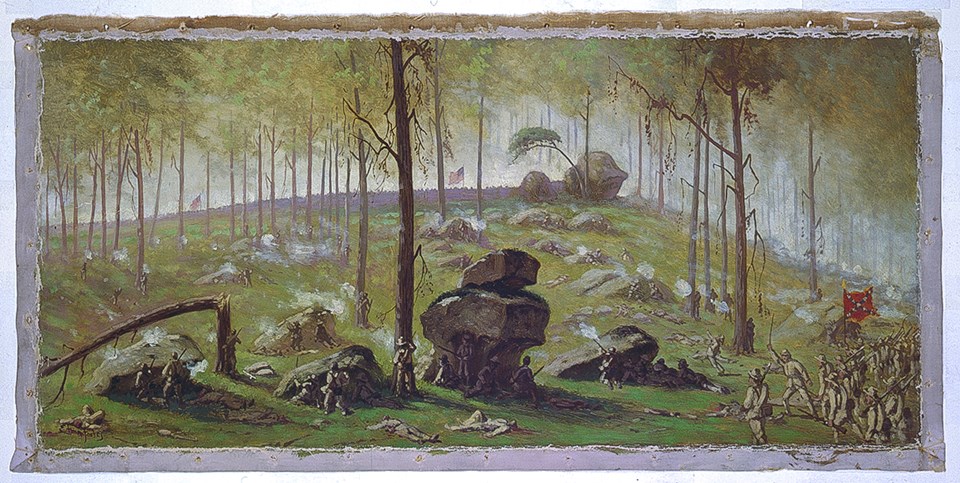
Occupied by Union troops all three days of the battle, was the critical right flank of the Union defensive line at Gettysburg. At mid-morning on July 2, elements of the Twelfth Corps arrived to reinforce the hill, including the 1,400 man brigade of George S. Greene. He reported, "As soon as we were in position, we began to intrench ourselves and throw up breastworks..."
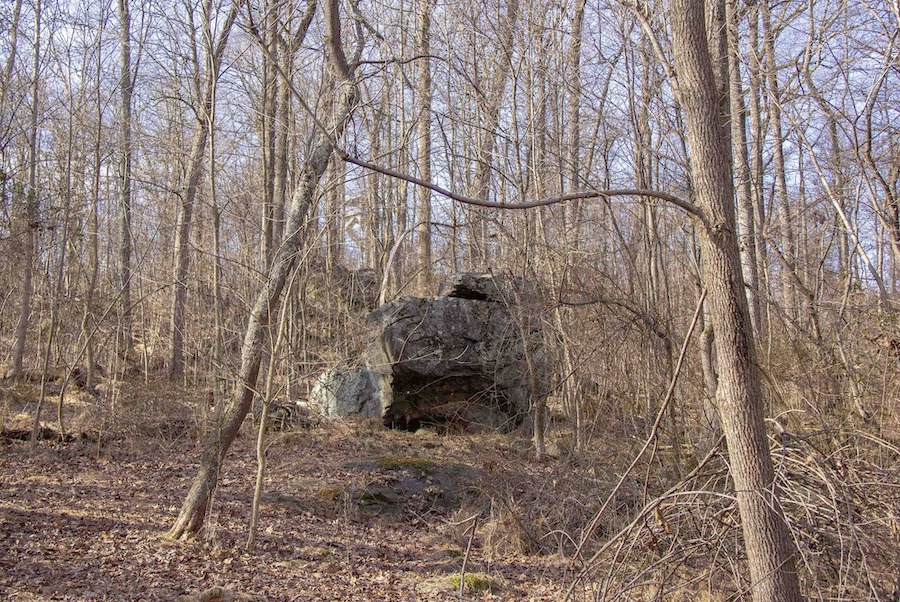
That night, his New Yorkers successfully held off 4,700 Confederates and held the upper summit. Before sunrise on July 3, fighting resumed with 22,000 Union and Confederate soldiers battling for the hill. One Union solider said, "The whole hillside seemed enveloped in a blaze." The Southerners attacked three times, but after six hours of fighting, the Union line held firm.
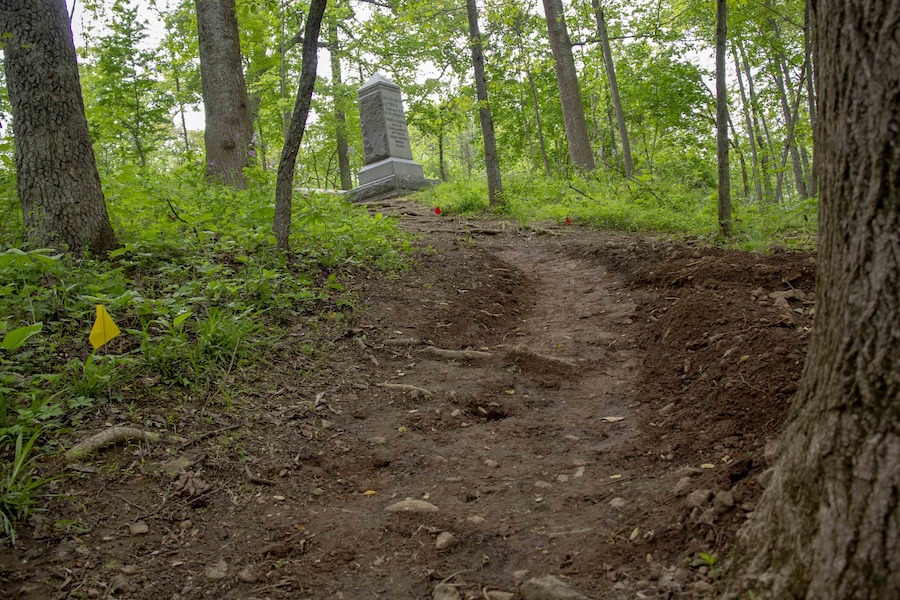
https://www.nps.gov/gett/learn/historyculture/culps-hill.htm
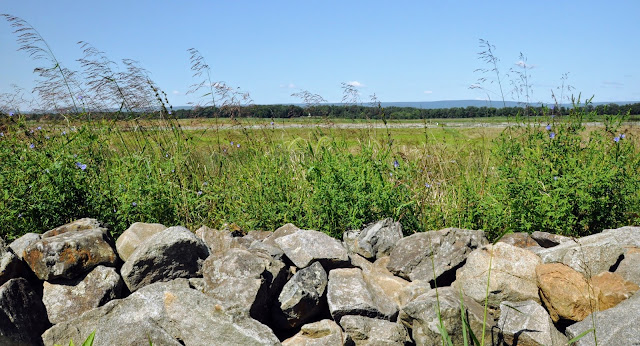
Cemetery Ridge:
The Union Army got to Gettysburg first, and thus claimed three ridges west of town (anticipating that the bulk of the Confederate Army would come from the west, as it subsequently did).
This delayed the Confederates on the first day of the three-day battle just long enough for Union reinforcements to arrive and occupy strong defensive positions south of town at Cemetery Hill, Cemetery Ridge, and Culp's Hill on the evening of July 1 and the morning of July 2.
Confederate reinforcements also arrived.
By the end of the first day's fighting, these three positions formed the Union lines; Confederates were arrayed along Seminary Ridge, roughly opposite Cemetery Ridge.
Cemetery Ridge formed a primary defensive position for the Union Army during the remaining two days of battle. Cemetery Hill overlooks the main downtown area of Gettysburg from the south; the hill gently slopes into Cemetery Ridge as it runs south. This area provided a site for Union artillery. At the northern end of Cemetery Ridge is a copse of trees and a low stone wall that makes two 90-degree turns, nicknamed The Angle.
Despite a ferocious attack on the second day of the battle, in which the Confederate troops almost breached the defensive line on Cemetery Hill, Union troops were able to repel the attack and hold Cemetery Ridge. The following morning, both sides engaged in a cannonade that could be heard miles away as hundreds of cannons from both sides were fired off for almost two hours. A massive Confederate artillery bombardment, meant to "soften up" the Union defense, was largely ineffective. Nevertheless, around 2 p.m. that afternoon, Pickett's Charge began, launching from Seminary Ridge. More than 12,000 Confederate soldiers from three divisions marched in a mile-long line across the farm fields. They encountered heavy artillery fire. Fencing and a slow upward incline increased casualties. The line shrank to less than half a mile long as casualties from first the shell and solid shot and then canister and musket fire piled up.
From Cemetery Ridge, Union troops arrayed along the stone fence fired upon the Confederate charge. Gaps opened up on the defensive line, allowing Confederates to reach several cannon -- the "High Water Mark of the Confederacy." The Confedeate troops turned the Union cannon to fire on the Union troops, only to realize there were no ammunition (luckily for the Union). Union reinforcements arrived and charged into the breach. With no senior officers remaining to call a formal retreat, Confederate troops began to slip away individually as they realized the defensive line was impregnable.
The following day, under a heavy rain, the Confederates withdrew. The momentous battle was over.
https://www.midatlanticdaytrips.com/2019/02/hiking-on-hallowed-ground-cemetery.html
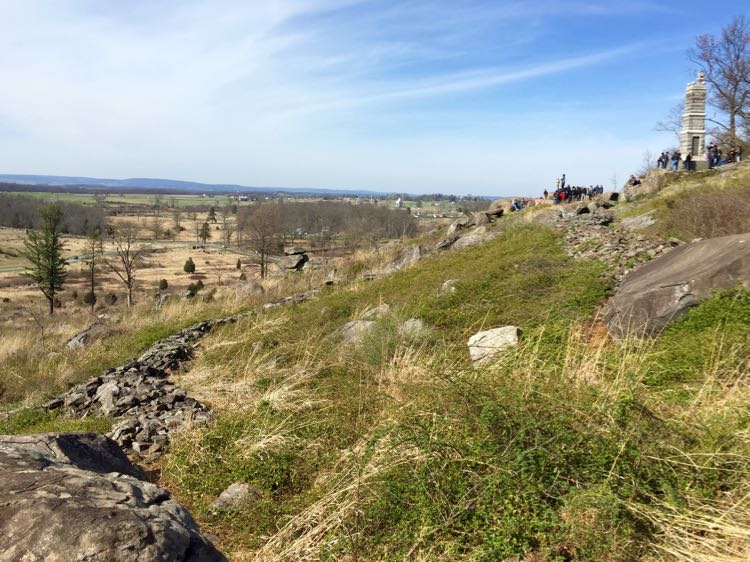
Little Round Top:
The hill commanded high ground that was occupied by Union forces who successfully fought off Confederate attack.
The hill overlooks Devils Den, the Wheatfield, and the Peach Orchard, all sites of fierce fighting and many casualties.
General Warren made the key decision to divert Union troops to Little Round Top so they could hold the strategic high ground which had been left undefended.
The high ground, rocky terrain and earthworks, and the tenacity of the Union soldiers blocked the Confederate attack. Ultimately, the Union forces preserved the western flank, and secured the Union position.
Perhaps best know for their bravery and determination during the battle of Little Round Top are the 20th Maine, commanded by Colonel Joshua Chamberlain. Chamberlain's men were told to hold the extreme left position of the Army of the Potomac at all costs. They repeatedly fought off Confederate attacks, and when their ammunition was almost exhausted, Chamberlain ordered a bayonet attack and flanking maneuver that repulsed the Confederates.
https://www.funinfairfaxva.com/view-from-little-round-top-gettysburg-nmp
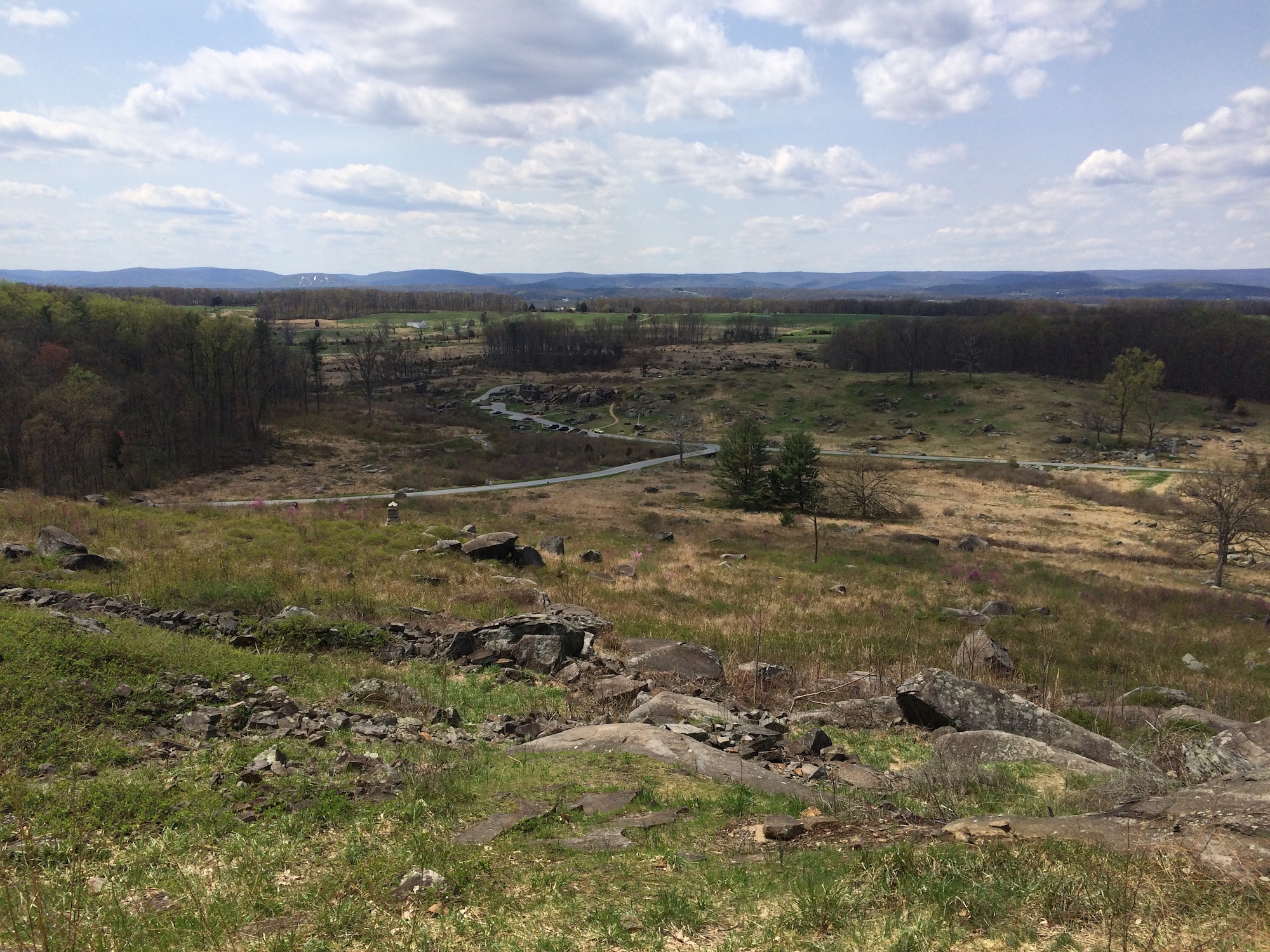
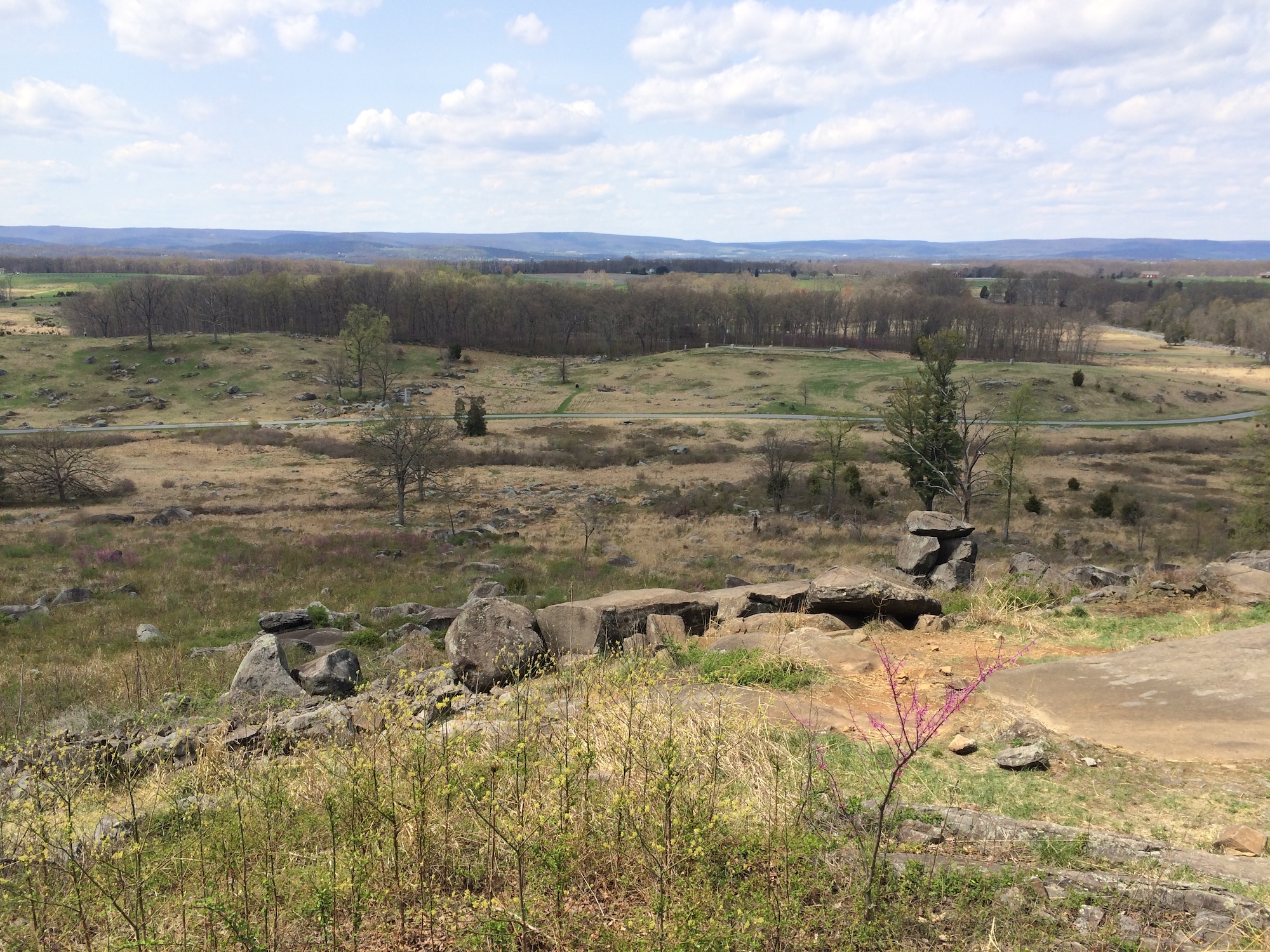
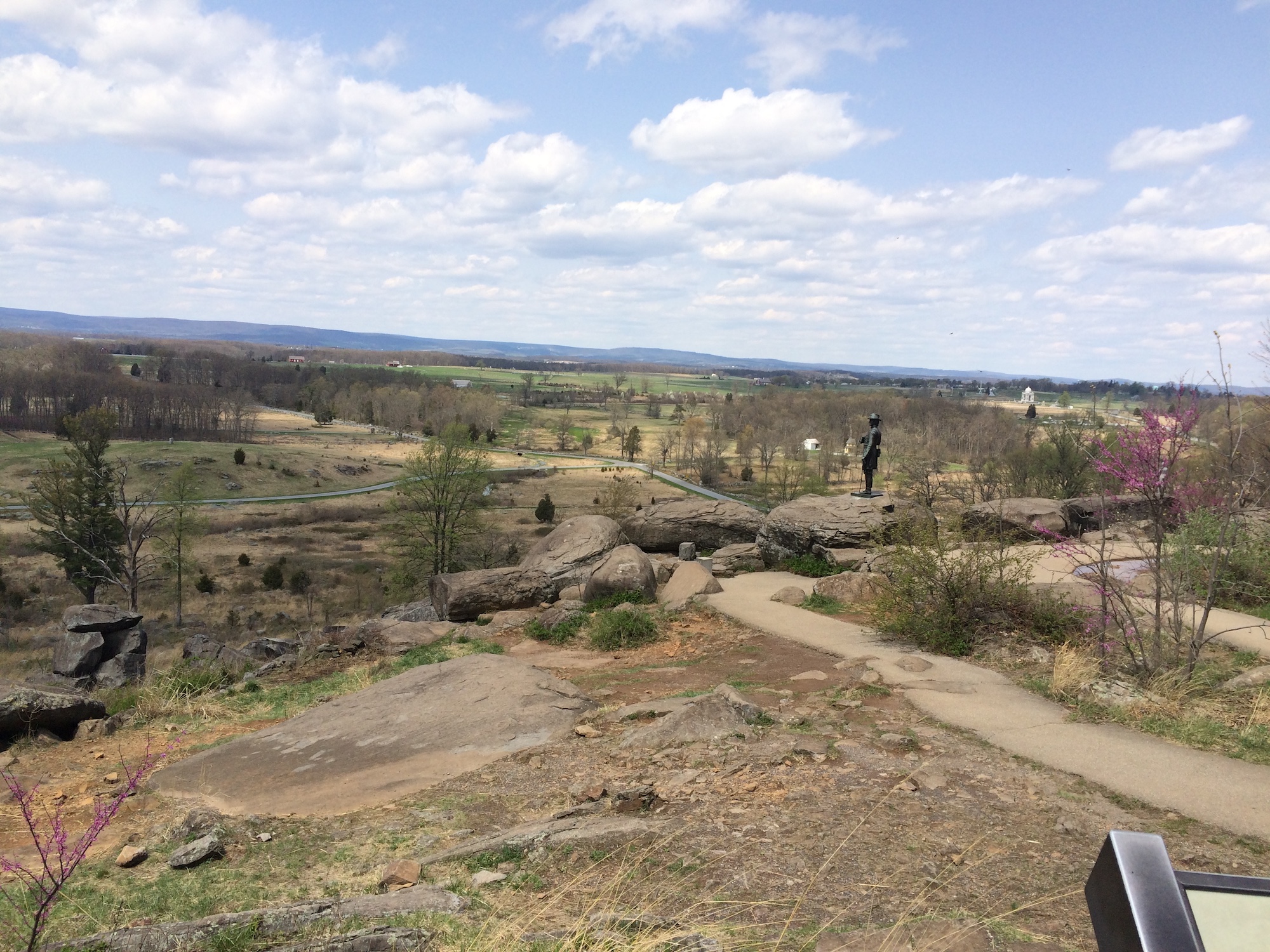
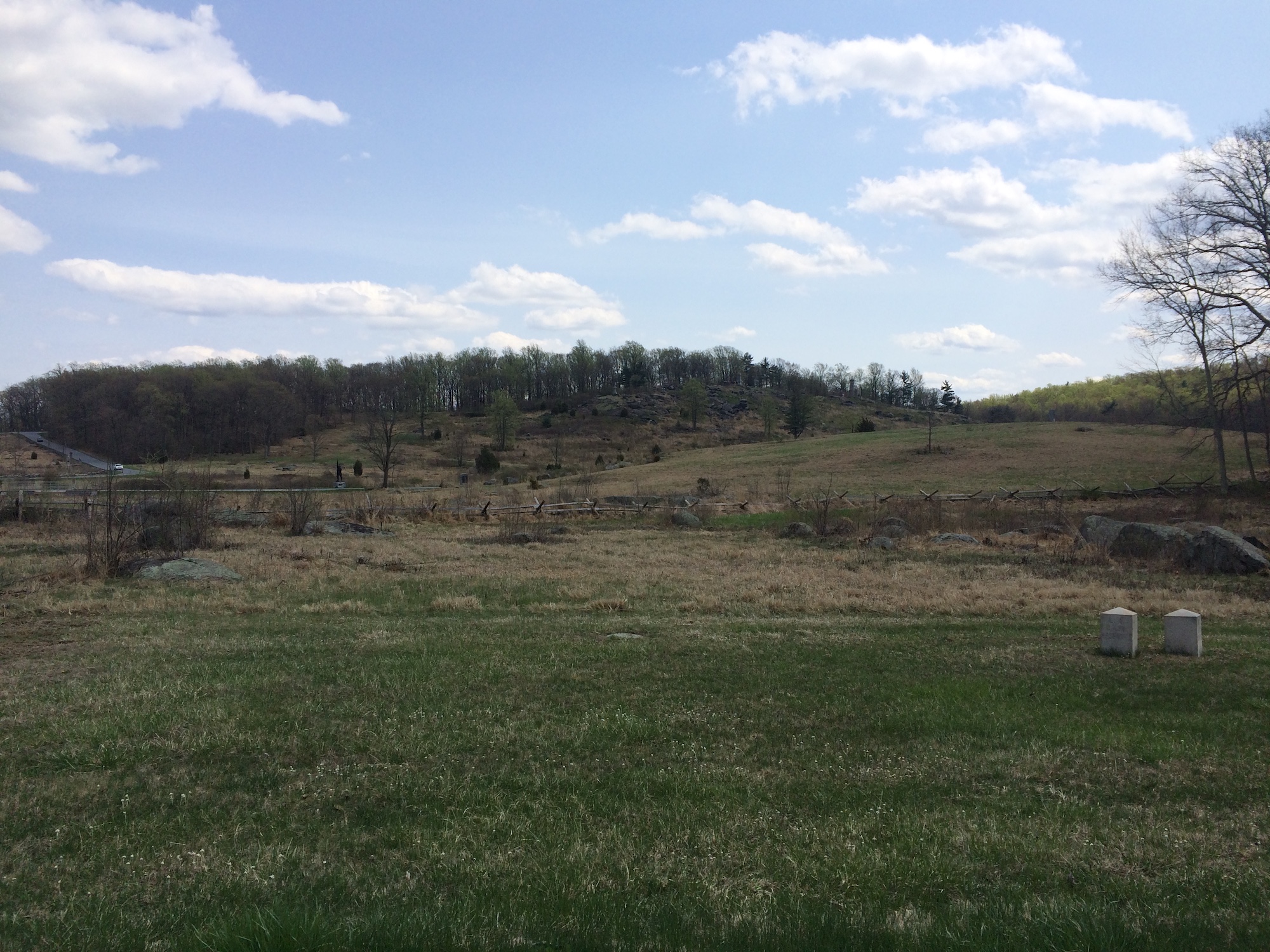
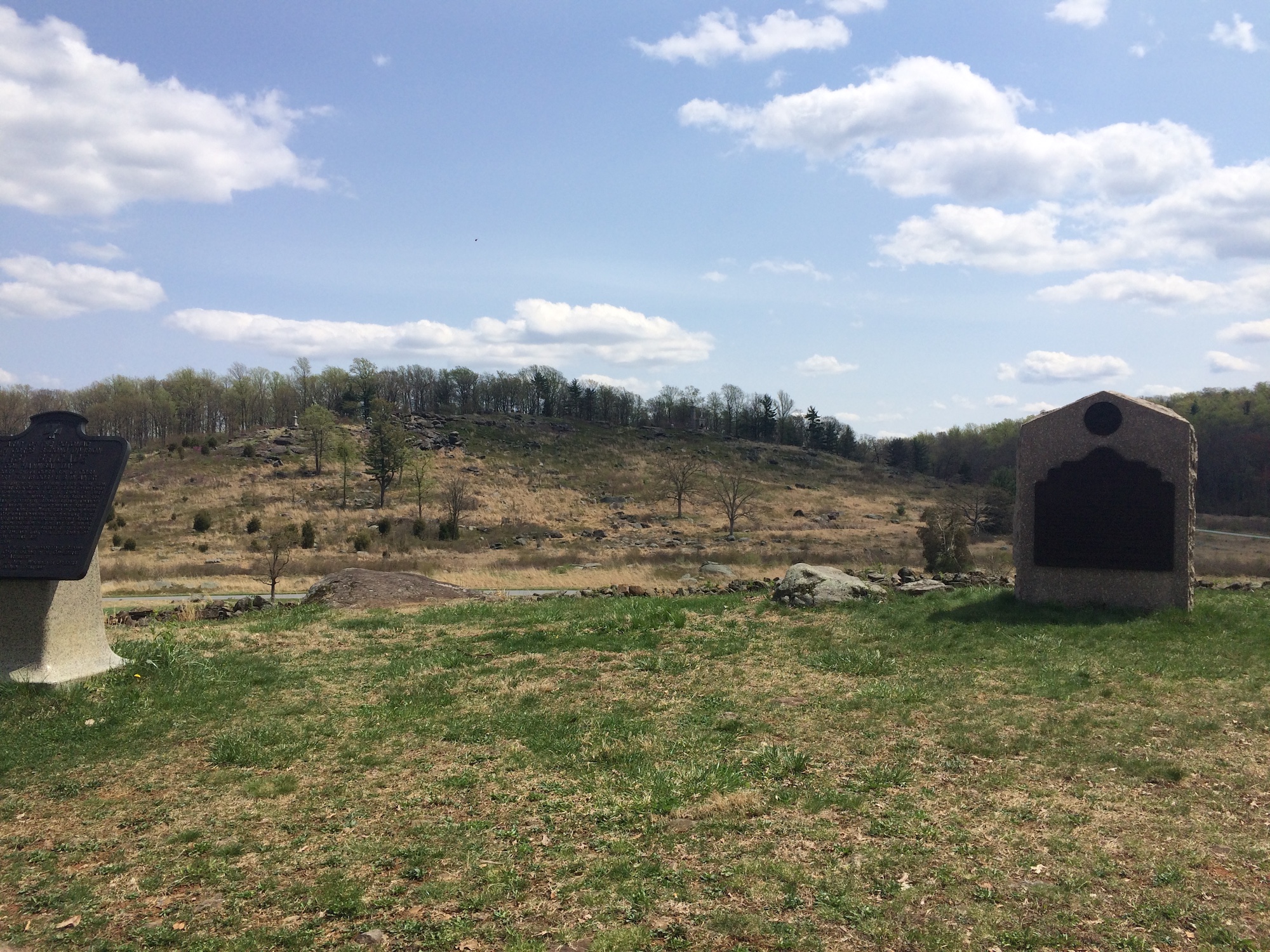
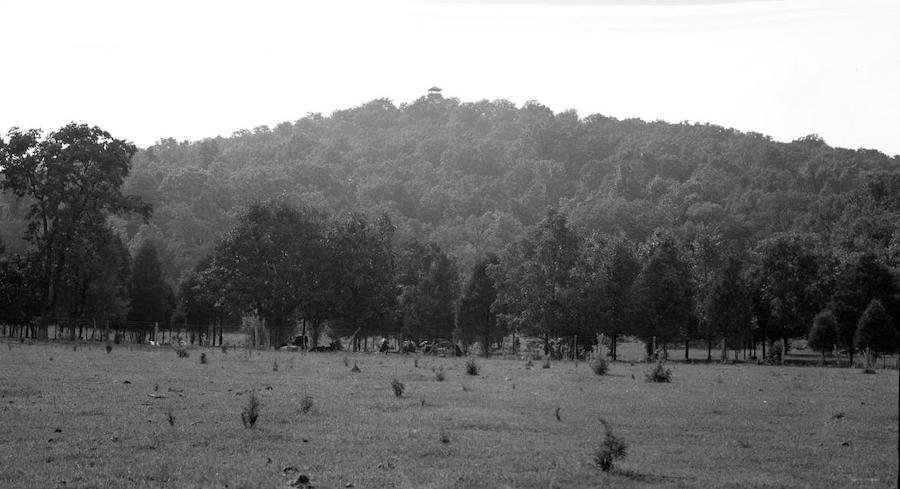
https://www.gettysburgdaily.com/climbing-big-round-top
Big Round Top:
Big Round Top is a boulder-strewn hill notable as the topographic high point of the Gettysburg Battlefield.
These sandstone and granite ridges and hills formed the essence of the Union "fishhook" defensive line on July 2 to July 4, 1863.
Big Round Top was heavily forested and covered with numerous large boulders and rock outcroppings, which made maneuvering military formations difficult at best, and precluded the positioning of any artillery on its crest.
Nevertheless, Confederate Colonel William C. Oates led two regiments of Evander Law's Alabama brigade across the slopes of Big Round Top during his famous assault on the lines of Joshua L. Chamberlain's 20th Maine Infantry on July 2, 1863. Oates' men had been ordered to attack Union troops occupying Devil's Den, but they were forced to move further to the right toward Big Round Top to escape the concentrated Federal artillery fire coming from the Wheatfield and Peach Orchard.
Oates had sent off a detachment to locate water for his thirsty men as they climbed the rugged slopes of Big Round Top, but the water bearers became lost in the dense underbrush and woods, and did not rejoin Oates until after the battle. Hence, his two regiments attacked Chamberlain with many soldiers suffering from heat exhaustion and extreme thirst in the hot, humid July weather.
After the fighting ended on July 2, the V Corps brigade of Joseph Fisher occupied a line across the western slope of Big Round Top, facing Oates' tired remnants that were positioned further down the hill. Colonel Chamberlain's depleted Maine regiment was sent in the evening to the crest of Big Round Top to recuperate and rest.
On July 3, a sharp skirmish occurred in an open D-shaped field on the western slope of Big Round Top. Newly appointed Brigadier General Elon J. Farnsworth led his cavalry brigade on a sweeping attack at the Confederate right flank, held by the division of Evander M. Law. Farnsworth's attack failed and he and his men circled back towards the Union lines on nearby Bushman Hill. As Farnsworth's column passed through the cleared field on Big Round Top, Confederate infantrymen killed the young general.
https://www.mycivilwar.com/battles/630701-roundtop.html
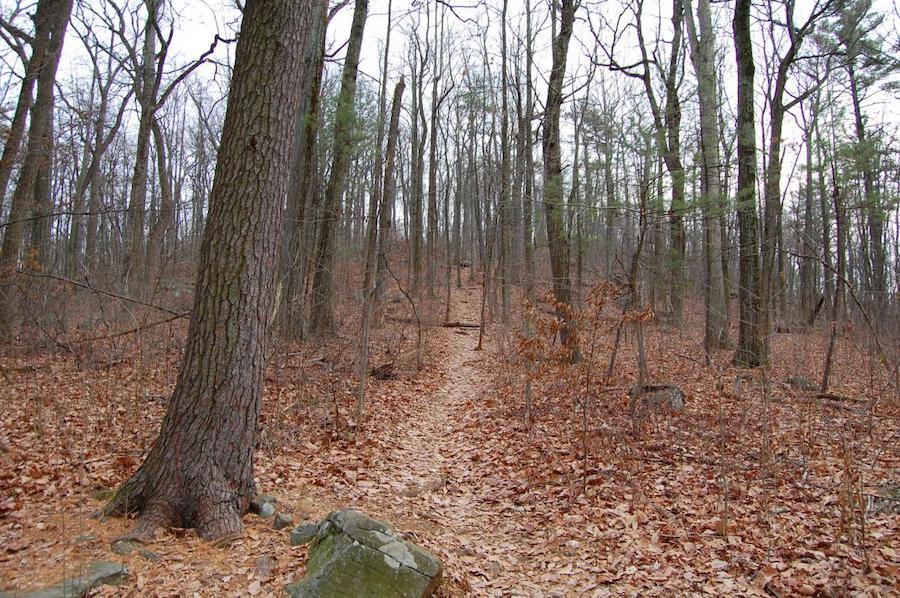
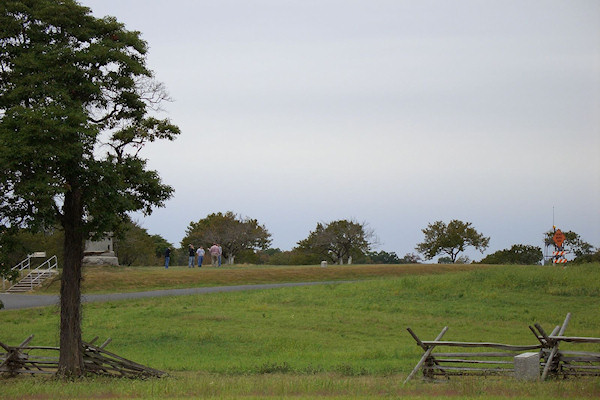
After the fighting on the first day of the battle, the Union troops retreated to high ground on Cemetery Hill, Culp's Hill, and Cemetery Ridge. They spent the night digging in and building defenses.
In the morning, General Daniel Sickles and his III Corps were ordered to take a position on the southern part of Cemetery Hill. Sickles thought the position was too vulnerable, and thought that the wheatfield and peach orchard a half mile to the west provided somewhat higher ground. So he moved his troops there. However, this actually exposed him, because he was so far ahead of the rest of the Union troops.
Meanwhile, General James Longstreet spent a good part of the day marching his two divisions via a roundabout route in an attempt to sneak up on the southern flank of the Union army on Cemetery Ridge. Longstreet was surprised to find III Corps occupying the wheatfield, peach orchard, and a boulder-strewn area to the south called Devil's Den. Longstreet attacked.
The fighting in all three areas was intense, with many casualties, especially for the Union troops. The Confederates briefly broke through the Union lines in the wheatfield and peach orchard, and the Union forces were forced to retreat to Cemetery Ridge, where General Sickles' troops were originally supposed to have been positioned.
The photo above shows part of the wheatfield in the foreground, and the peach orchard in the background. You can see that there is a slight rise to the ground in this area. However, General Meade, the Union commander at the Battle of Gettysburg, reprimanded General Sickles, saying, "General Sickles, this is in some respects higher ground than that of the rear, but there is still higher in front of you, and if you keep on advancing you will find constantly higher ground all the way to the mountains!
The Confederacy lost 39% of its manpower due to the sheer volume of soldiers wounded there and was never again able to threaten the North.
In fact, the loss at Gettysburg was so detrimental to the South that it may have cost the Confederates the entire war.
That being said, if ghosts do exist, the battlefield at Gettysburg must be crawling with them. And if the video below is to be believed, two of them like to cross the street in the dark in front of moving vehicles.
One of the "ghosts" could be just a drop from precipitation outside the vehicle.
0:54 Youtube Video:
Gettysburg 'ghosts' run across road in this bone-chilling video | New York Post
Two "ghosts" at Gettysburg, Pennsylvania, were spotted — 157 years after the infamous Civil War battle. See the spooky sight for yourself, filmed by New Jersey resident Greg Yuelling, as he drove through the historical battleground with his family on Sept. 2, 2020.
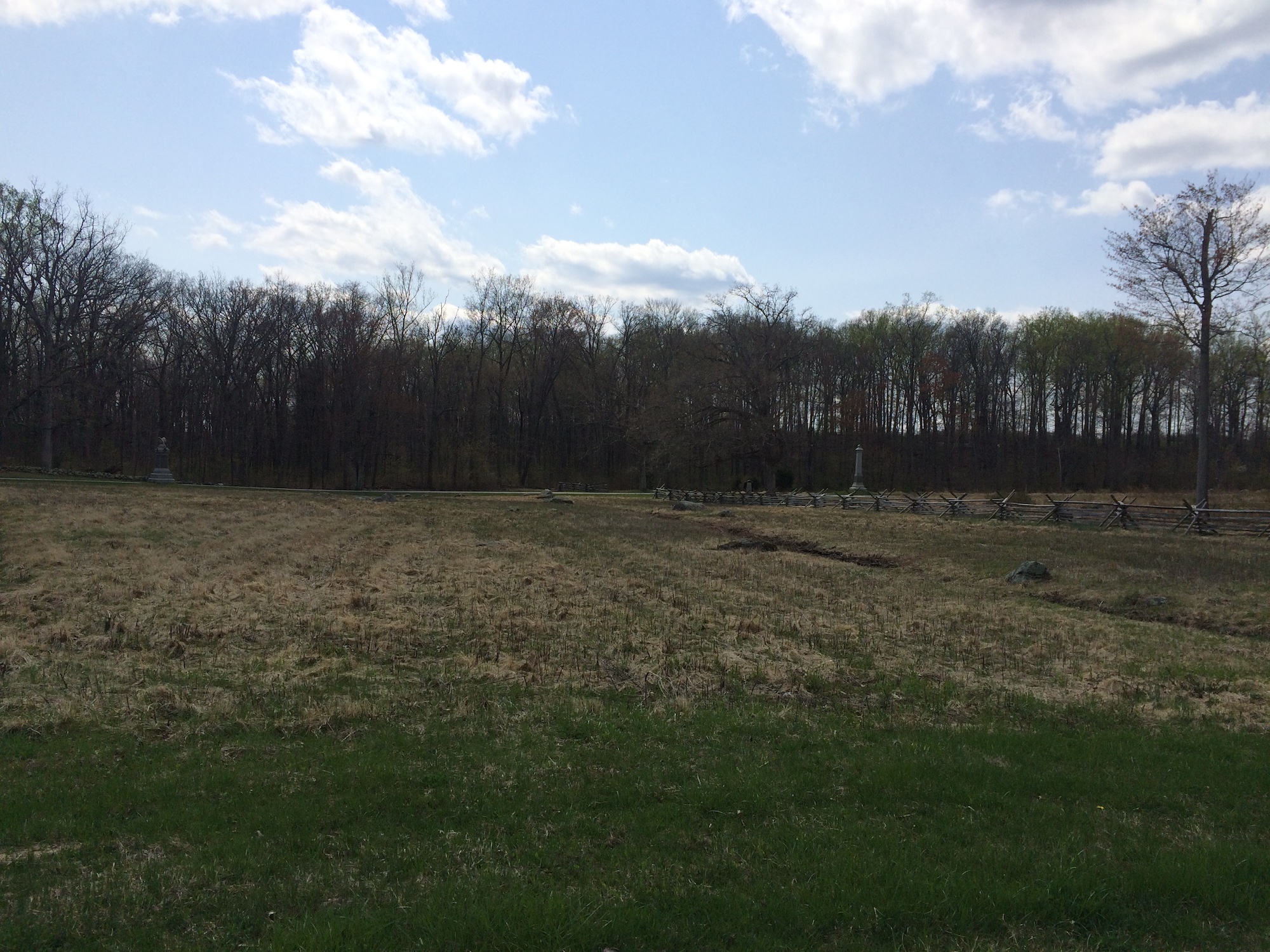
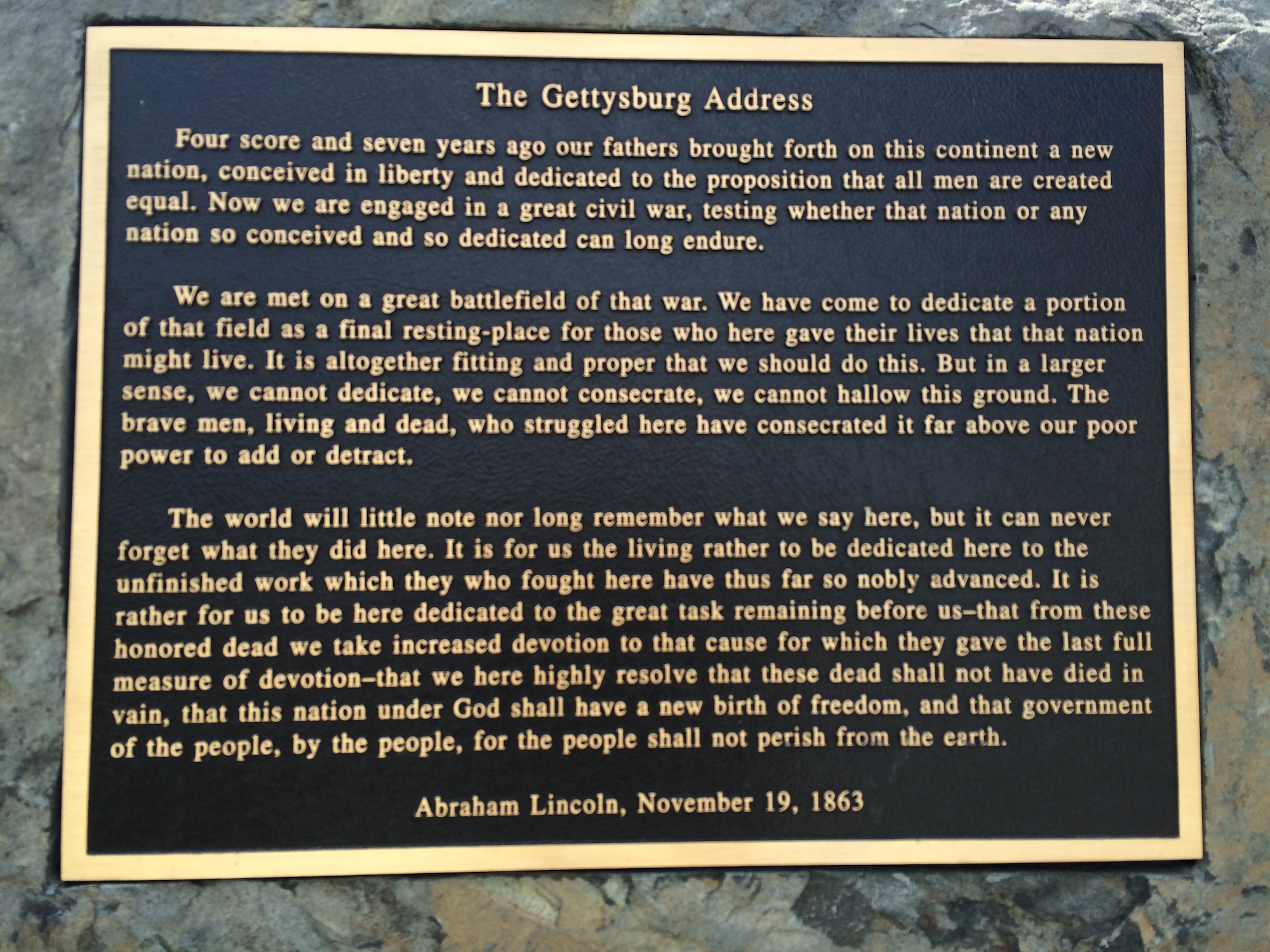
Four score and seven years ago our fathers brought forth on this continent a new nation, conceived in Liberty, and dedicated to the proposition that all men are created equal. Now we are engaged in a great civil war, testing whether that nation or any nation so conceived and so dedicated can long endure.
We are met on a great battle-field of that war. We have come to dedicate a portion of that field as a final resting-place for those who here gave their lives that that nation might live. It is altogether fitting and proper that we should do this. But in a larger sense, we can not dedicate, we can not consecrate, we can not hallow this ground. The brave men, living and dead, who struggled here have consecrated it far above our poor power to add or detract.
The world will little note nor long remember what we say here, but it can never forget what they did here. It is for us the living rather to be dedicated here to the unfinished work which they who fought here have thus far so nobly advanced. It is rather for us to be here dedicated to the great task remaining before us—that from these honored dead we take increased devotion to that cause for which they gave the last full measure of devotion—that we here highly resolve that these dead shall not have died in vain, that this nation under God shall have a new birth of freedom, and that government of the people, by the people, for the people shall not perish from the earth.
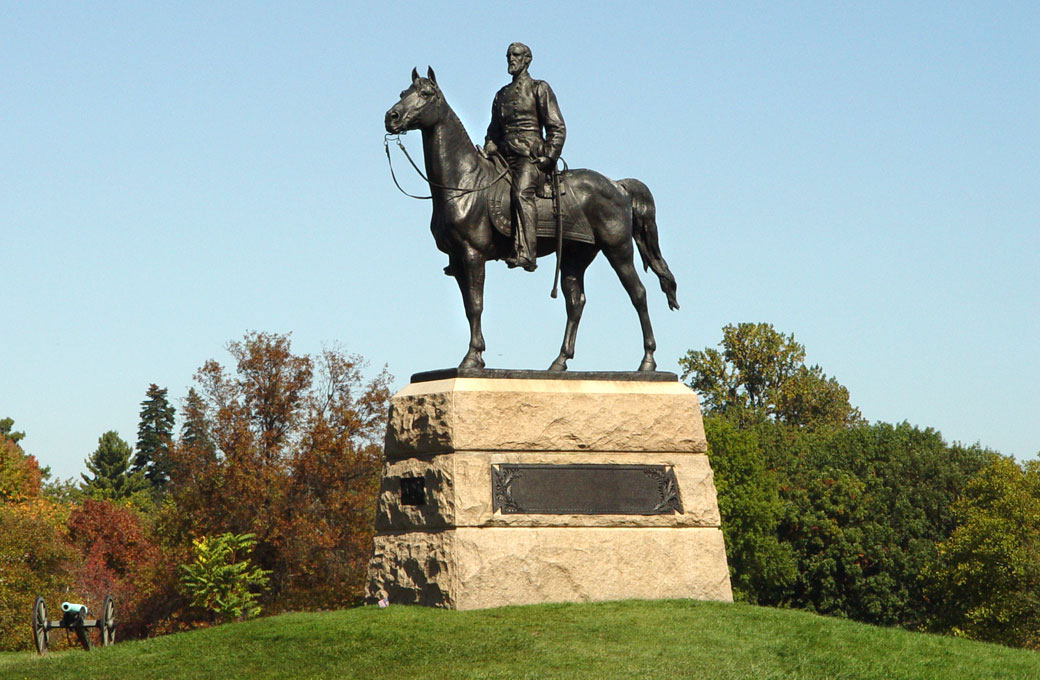
The monument features General Meade seated on his horse, Old Baldy. He is looking out over the field where Pickett's Charge was turned back in what would come to be called the high water mark of the Confederacy. When the State of Virginia monument was built some twenty years later a mile away across the field, its statue of Robert E. Lee looks back at Meade. The two army commanders face each other across eternity.
Old Baldy:
Old Baldy was a cavalry mount ridden by General David Hunter at the Battle of Bull Run. He was wounded there but returned to service. Meade purchased him in the fall of 1861.
Meade rode Old Baldy at Gettysburg. The horse was wounded on July 2nd by a ball that entered his stomach after passing through Meade's trouser leg within a half inch of his thigh. Old Baldy again survived, but after another wound he was considered unfit for service in August of 1864, and Meade sent him back to Philadelphia for a well-deserved retirement. Old Baldy did so well in his retirement that Meade resumed riding him after the war. The horse survived the general by ten years, taking part in Meade's funeral procession in 1872 as the riderless horse. Old Baldy died in 1882.
https://gettysburg.stonesentinels.com/monuments-to-individuals/george-meade
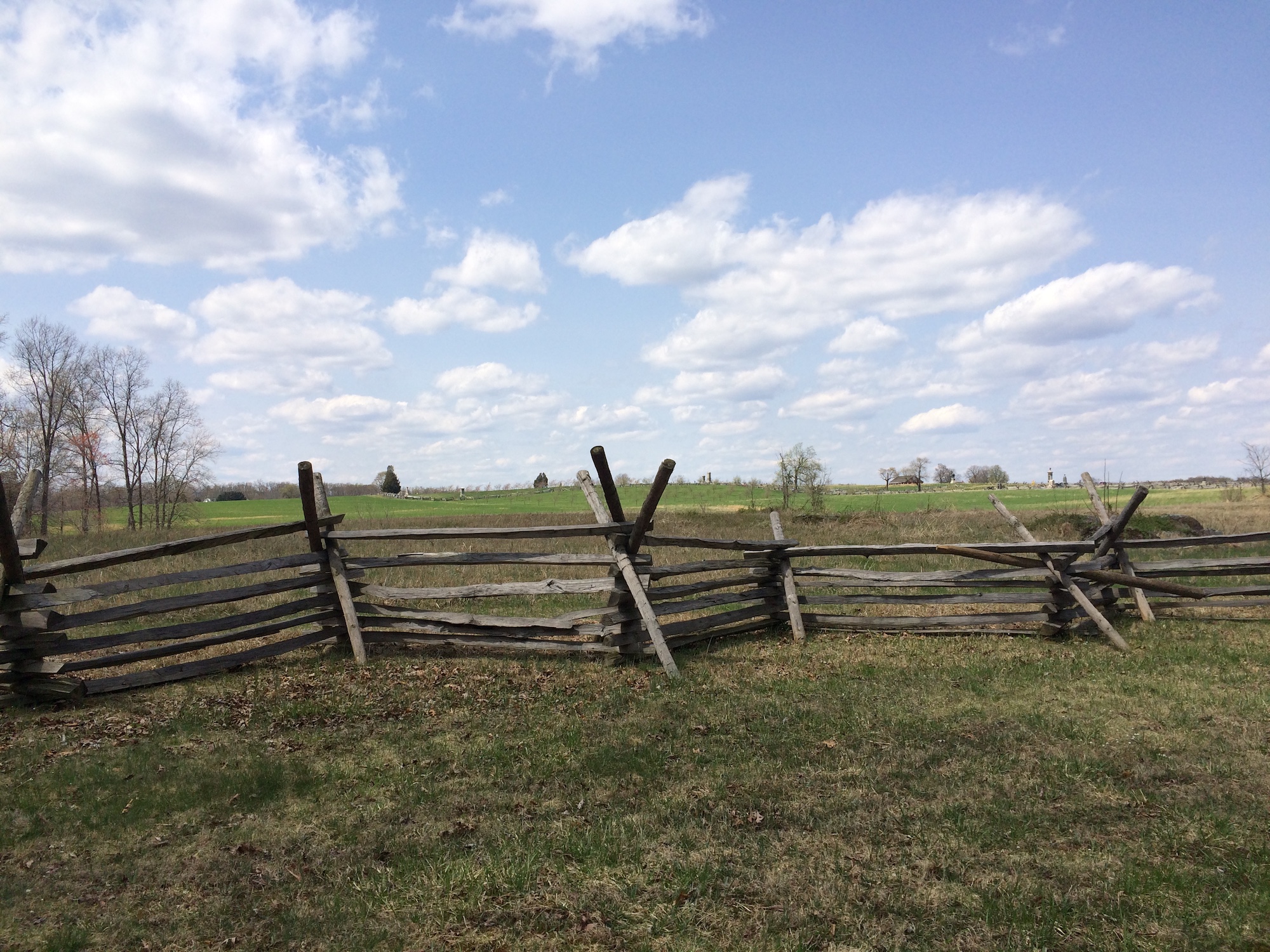
Part of the American Civil WarBattle of Gettysburg:
- July 1–3, 1863
- In and around the town of Gettysburg, Pennsylvania
- Union Major General George Meade's Army of the Potomac vs Confederate General Robert E. Lee's Army of Northern Virginia
- The Union defeated attacks by the Confederates, halting Lee's invasion of the North
The battle involved the largest number of casualties of the entire war
- It is often described as the war's turning point due to the Union's decisive victory and concurrence with the Siege of Vicksburg.
The Gettysburg Campaign:
After his success at Chancellorsville in Virginia in May 1863, Lee led his army through the Shenandoah Valley to begin his second invasion of the NorthWith his army in high spirits, Lee intended to shift the focus of the summer campaign from war-ravaged northern Virginia and hoped to influence Northern politicians to give up their prosecution of the war by penetrating as far as Harrisburg, Pennsylvania, or even Philadelphia.
Prodded by President Abraham Lincoln, Major General Joseph Hooker moved his army in pursuit, but was relieved of command just three days before the battle and replaced by Meade.
July 1, 1863:
Elements of the two armies initially collided at Gettysburg, as Lee urgently concentrated his forces there, his objective being to engage the Union army and destroy it.Low ridges to the northwest of town were defended initially by a Union cavalry division under Brigadier General John Buford, and soon reinforced with two corps of Union infantry.
However, two large Confederate corps assaulted them from the northwest and north, collapsing the hastily developed Union lines, sending the defenders retreating through the streets of the town to the hills just to the south.
July 2, 1863:
On the second day of battle, most of both armies had assembled. The Union line was laid out in a defensive formation resembling a fishhook. In the late afternoon Lee launched a heavy assault on the Union left flank, and fierce fighting raged at Little Round Top, the Wheatfield, Devil's Den, and the Peach Orchard. On the Union right, Confederate demonstrations escalated into full-scale assaults on Culp's Hill and Cemetery Hill. All across the battlefield, despite significant losses, the Union defenders held their lines.July 3, 1863:
On the third day of battle, fighting resumed on Culp's Hill, and cavalry battles raged to the east and south, but the main event was a dramatic infantry assault by 12,500 Confederates against the center of the Union line on Cemetery Ridge, known as Pickett's Charge. The charge was repelled by Union rifle and artillery fire, at great loss to the Confederate army. Lee led his army on a torturous retreat back to Virginia.Casualties:
The most costly in US history. Between 46,000 and 51,000 soldiers from both armies in the three-day battle.November 19, 1863:
President Lincoln used the dedication ceremony for the Gettysburg National Cemetery to honor the fallen Union soldiers and redefine the purpose of the war in his historic Gettysburg Address.
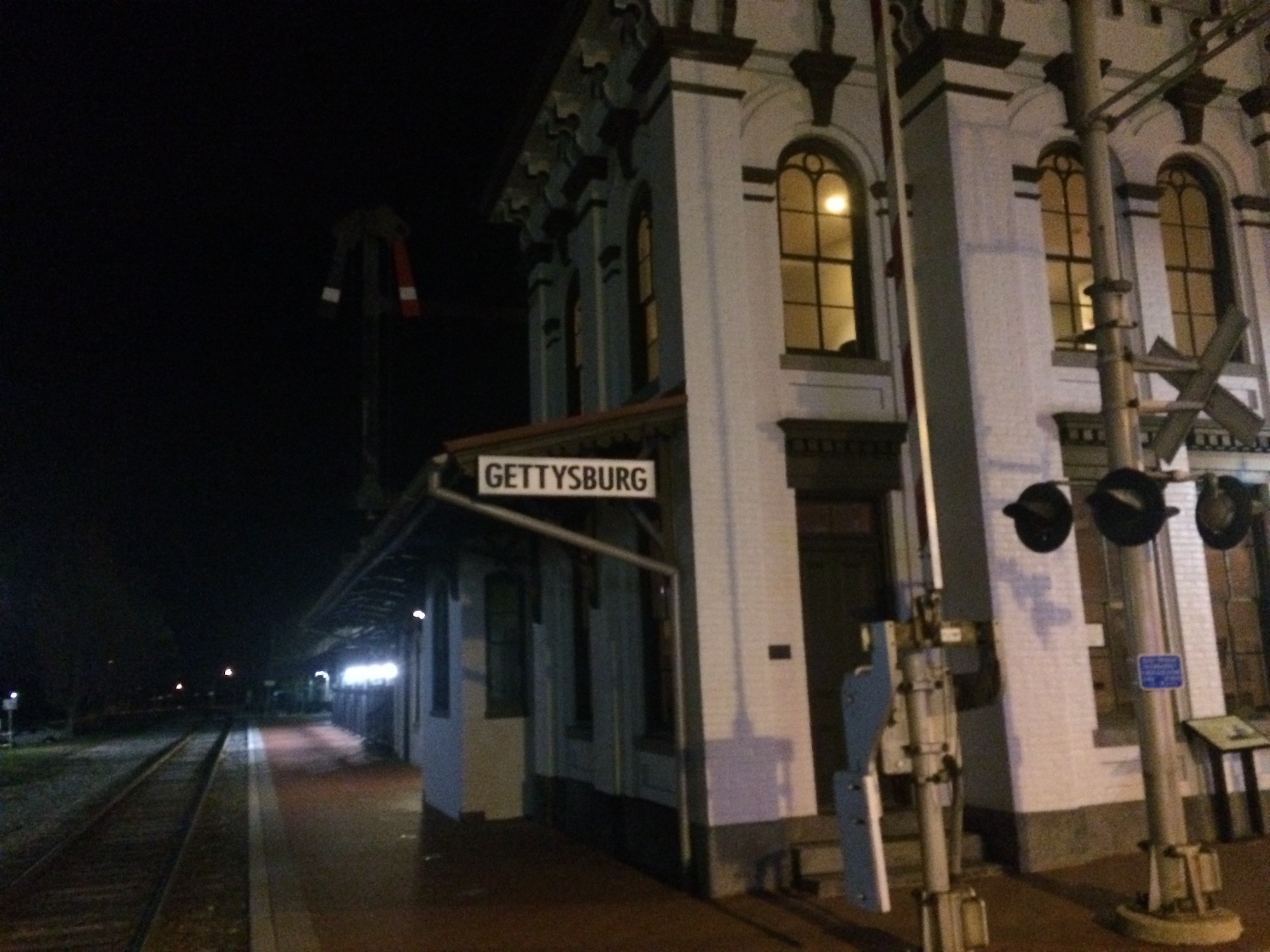
Abraham Lincoln arrived here on November 18. This structure was also a vital part of the recovery efforts after the battle, as a depot for delivery of supplies and evacuation of the wounded.
 https://www.gettysburgfoundation.org
https://www.gettysburgfoundation.orghttps://www.nps.gov/gett/index.htm
1195 Baltimore Pike
Gettysburg, PA 17325
